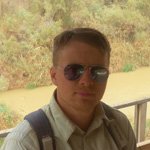Expedition to Jordan 2015
All travel reports are translated electronically although minor improvements are sometimes made.
Expedition to Jordan 2015
My trip: Amman, Jerash, Azraq – castles in the desert – Zarqa – 7 sleeping caves, Madaba, Mukawir, Mt. Nebo – the baptism site of Jesus on the Jordan River – Dead Sea, Diban, Wadi Mujib Canyon, Karak, Al Mazra – Dead Sea, Dana National Park, Al-Qadisiyah, Shobak Castle, Wadi Musa, Petra, Wadi Rum, Aqaba, passage Wadi Araba border.
In the beginning I want to say that Jordan was one of the most beautiful and interesting experiences of my Arab travels, and I think that every traveler should invest his time and money to get to know Jordan, to some extent. Petra was great, adventurous and extraordinary, although I warn you that Jordan is not just about Petra. Also, we should never compare that beautiful country and its hospitable people to the criminal sewage from the Muslim countries that is flooding Europe. They are two different worlds.
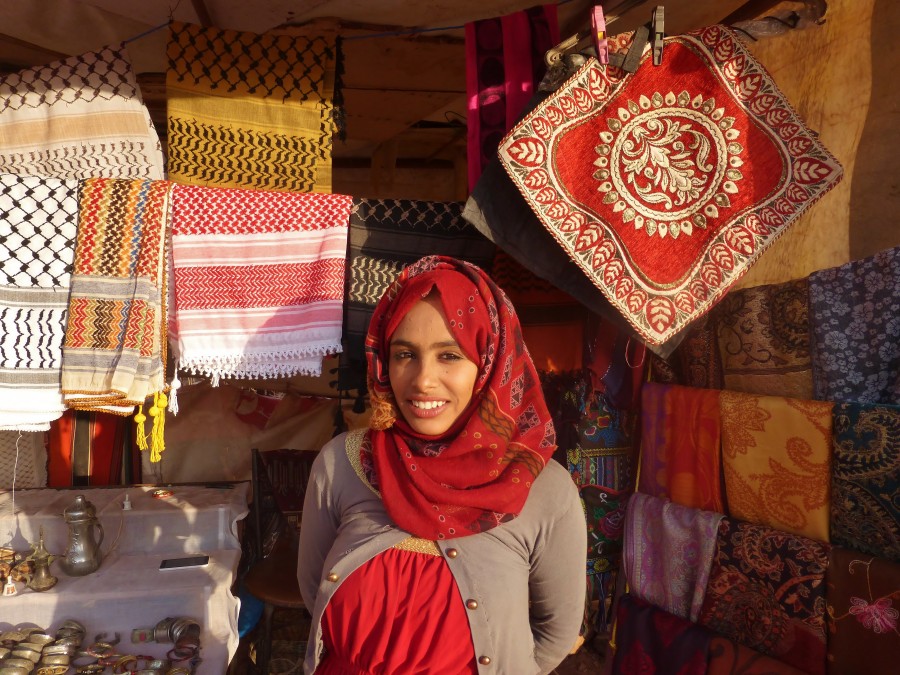
Jordanian beauty.
Amman
After a short flight from Lebanon, I landed in Jordan. Although I was still a little sick because I was poisoned in Lebanon, I had a lot of energy, as always in the case of a new country. At the airport, however, the price of the visa, which cost as much as 40 Jordanian dinars, broke down, and I will remind you that the currency of Jordan is almost equal to the British pound. From the airport I took the Sirousa Express autous for 3JD, to the road to Downtown, and from there I took a 1.5JD taxi to the cheapest hostel in Jordan for 5JD.It was a cliff hostel, which although extremely cheap, was very pleasant and located in a strategic place for travelers. Nearby, there was the Roman Tetar and the Hippodrome, and the rest of the monuments were also nearby. On the first day I was just resting and taking antibiotics. I was also laundered because my things still stank of a Lebanese adventure, then I went to the Internet and went to the Jerusalem restaurant, where they finally gave me rice. When I felt better, I went to the fruit bazaar and small shops where they sold pomegranate juice and made sandwiches, but nowhere could I find the boiled eggs. I also find it interesting that one of the Jordanian banknotes has the Ala-Aqsa mosque (“Temple of the Rock”), although it is in occupied Palestine. It is understandable that the Arabs treat Palestine as their land, and Israel as a colonial occupant.
While walking around Amman, I also saw many stores with perfumes, which the Arabs themselves do and pour into bottles, in quantities that the client wants. Almost original perfumes are very popular in all Arab countries and smell the same as the original ones. Arabs prefer sharpening fragrances because they sweat more, so you can, for example, order every brand perfume, but “more expressive”, as it was assumed to define them. I bought 100ml Farhenheit for only 5JD, while in London I would have to pay about £ 80. So there is a huge difference, and that’s why I buy perfumes in every Muslim country. I also recommend Turkey and Iraq, of course. Late in the evening I also came to many very interesting souvenir shops, which I heartily recommend. There you can find real treasures closely related to the culture and tradition of Jordan. Besides, people ate chickens with rice in medium-clean but pleasant pubs and others smoked Shisha on the streets. In the evening, when the hot sun fell, the Arabs left with their children near the Roman Theater to spend time on family life outside. It was nice and I was enjoying my presence in the capital of Jordan.
But there was something else. On the street I saw two White women who in a conservative Arab country were walking in very short shorts and skimpy T-shirts after dark, and all men were obviously very excited. The hostel was inhabited by an English and Canadian queens of liberalism and diversity, who provoked Arabs as if they were going to jump out of the window in a moment; and they of course chose me as the local symbol of evil and did not want to talk to me at all, because I asked them how many white people there were still left in Vancouver. At one point, 6 horny Arabs invited them for a trip to the desert in the evening, to which they replied with a smile that they would think about it. Will those stupid white whores ever learn anything? Do white people have any chance? In this case, I cannot blame the Arabs.
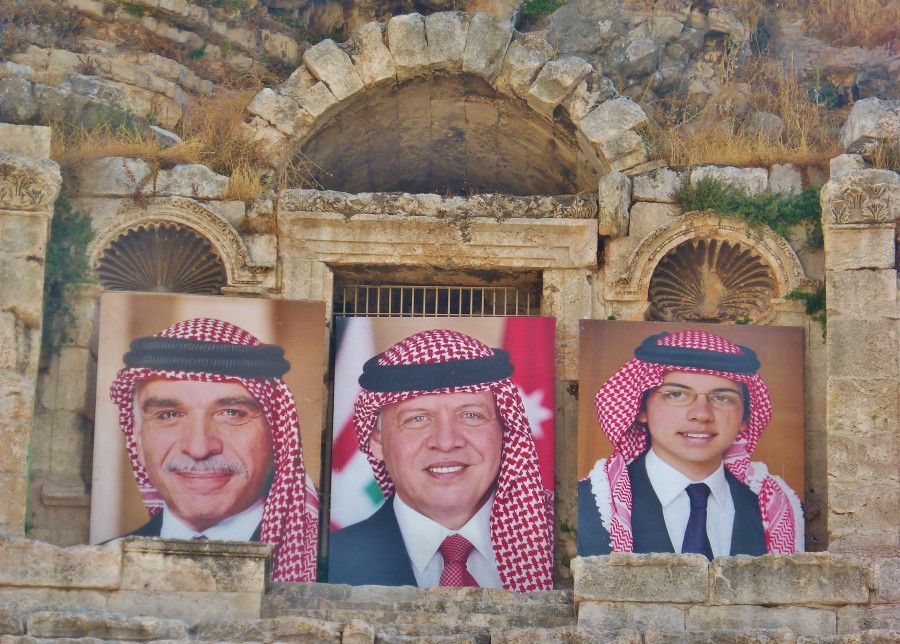
Jordanian kings and the young prince. Amman, Jordan.
I spent the whole next day visiting Amman, so I got up early so I could see everything. Besides, Amman was my base for some time, because I organized a few trips from there, and then I went back to my nice hostel. After the morning pomegranate juice, I went first to see the Al-Husseini mosque , which can not be missed because it is located on the main road, near the Roman Theater. This mosque was built by King Abdullah in 1924 and stands in the center of Downtown. It has two high minarets and is a popular meeting place. In addition to prayers, non-Muslims can explore the interior. Next to the mosque is an interesting vegetable and fruit bazaar, which I recommend because of contact with people, as well as grapes and dates.
Then I went to see the ruins of the Nymphaeum , a public fountain built by the Romans in the second century. During Roman times such fountains were very popular and built with great gusto. Where today there are ruins, once stood an object on 600 square meters, which was deep on 3m and filled with water.Today, however, this place is very neglected, especially that it fades at other monuments. After a few minutes walk he got to Haszemidzki Square, which is another popular meeting place, where in the evenings entire families with children come, they are always obciągnia seller and a few Roman columns. Hashemite Square occupies 50,000 sq m and in addition to free space, there are also cafes, car parks, gardens and fountains nearby. From the traveler’s point of view, this is a very important place as there is the Roman Theater and Odeon as well as the previously described Nymphaeum. From the square you can also see the hill where the Citadel is located, although this is a longer walk. I also think that attention should be paid to residential buildings, or gray-bure blocks, which are the reality of Jordan.
The square is an obvious reference point to the huge Roman Theater, which is the biggest tourist attraction of Amman. The Roman Theater is a beautiful, great monument built around the second century, which has the shape of a semi-circle, has three main floors and is able to accommodate 6,000 spectators. The first rows nearer to the stage belonged to the nobly born, the middle rows to the soldiers, and on the far side a crowded crowd sat watching the performances below. The theater also had a religious significance, because there is a small chapel upstairs, once a statue of Athena, which is now safe in the Archaeological Museum. There are also two museums in the theater, though my attention was drawn to pillars right through the entrance, which are the remains of the Forum, a square built in the second century. In my opinion, the Roman Theater is a must-see for the capital of Jordan and is the cultural identity of Amman. Today, interesting performances with spectacular lights take place inside the antique theater. The entrance cost me only 1JD.
In the eastern part of the theater stands the Odeon , which is a small, round theater that can accommodate 500 spectators. It is the best preserved building from the former Forum, which was mainly used for small performances. This building was built in the second century and the entrance is free. It is possible that once Odeon was covered by a wooden roof, but today there is no trace of him. Although it is a much smaller object than the theater, I consider it more moody. I felt that due to its closure I had better contact with history because I did not see the traffic of Amman. From there, I walked up the small streets, towards the Citadel and museums.
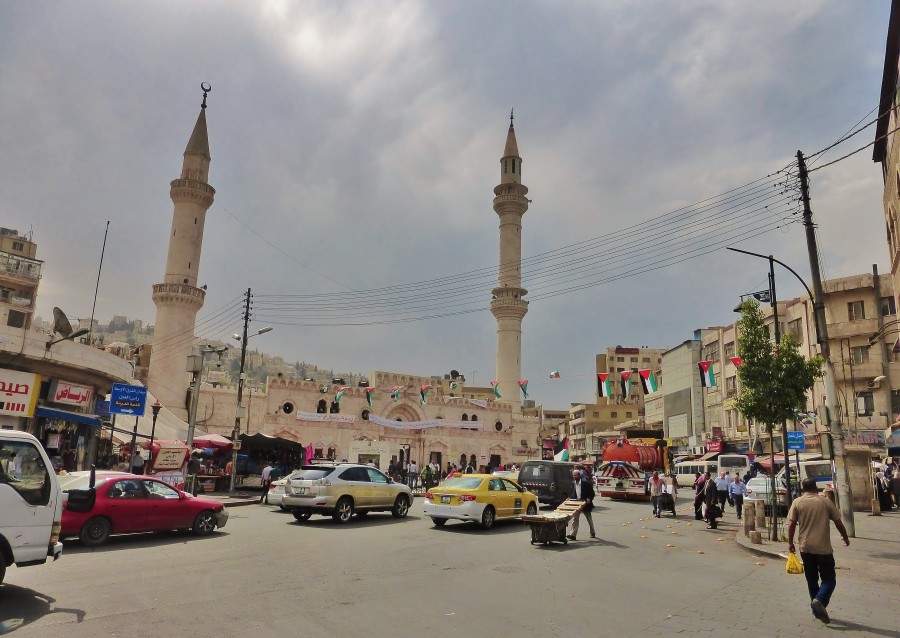
Amman and the Al-Husseini mosque. Jordan.
The citadel (Jebel al-Qala’a) is located on the highest hill of Amman at 850m altitude. Monuments found at the top of the Bronze Age testify to the fact that the Citadel was a mountain fortress, also of political and commercial importance for thousands of years. The Citadel in Amman is surrounded by a defensive wall, 1700m long, which was repeatedly rebuilt in the Bronze and Iron ages, also in Roman, Byzantine and Umayyad times. Inside, there are several impressive, ancient buildings, such as the Umayyad Palace from around 270 years, which only partially survived due to the earthquake of 749. which despite the earthquake still stands in one piece, has moderately preserved moiosiki, bas-reliefs on the outer walls, and a blue dome.
The Umayyads also built a huge pit called the Cistern, whose task was to supply the Citadel with water.Pay attention to the stairs, after which the inhabitants went down to collect the water. At the top there are also a few squares and an auditorium, whose main opinion was to arouse the admiration of the guests.Christians left here a Byzantine Basilica from around the 6th-7th centuries, after which unfortunately there was nothing but the base, a few pillars and mosaics. An important element of the Citadel is also the Temple of Hercules, built during the times of Marcus Aurelius, in the years 161-180. To this day, only a few columns remain, the base of the temple, and stone fingers, which once probably belonged to the monument of one of the Roman gods. Walking around the Citadel, I began to suspect that it was a city for the rich and privileged, located above the city for the poor who lived below. It is possible that after some time, especially during Roman times, the Citadel was a reflection of Olympus, because rich people wanted to feel divine, and the fortified function of the Citadel did not bother. You could not get to Olimp either.However, I have no evidence for this. This is just my cultural-historical speculation.
Near the Temple of Hercules there is also the National Archaeological Museum, which has collections dating back to 6500 BC, from ancient Greece, Rome and Egypt. These are mainly statues of the gods of these civilizations, as well as finds excavated in Jerash and Petra. Of course, the entire Citadel is a great attraction of Amman and it should not be avoided. Attention should also be paid to the skyline of the city with the Flemish of Jordan in the background. I paid 3JD for entering the Citadel in Amman.
After leaving the Citadel, I went to a hairdresser who was not far from the entrance. The whole plant was very excited, and the hairdresser who cut my hair asked me a lot of questions about Poland and Poles, and how I like Jordan. I have always told the truth that I love Jordan, and I have a good opinion about people too. They also asked me if I liked Islam, to which I replied that I respect their culture and that’s why I am glad that it is in Jordan (and not in Poland;). The hairdresser was so excited about me that before he got to work, he first called a few colleagues to come and look at me. The hairdresser’s was dirty and the Arabs were sweaty and did not smell too good, but on the other hand I think that this was my real travel experience, which I am happy with. The Jordanian hairdresser, on the other hand, though he was cheerful and tried hard, made me a staircase and he did not quite finish it. So I asked him if he had shaved sheep and goats before, which he honestly replied that he did. We already know how to become a hairdresser in Jordan.
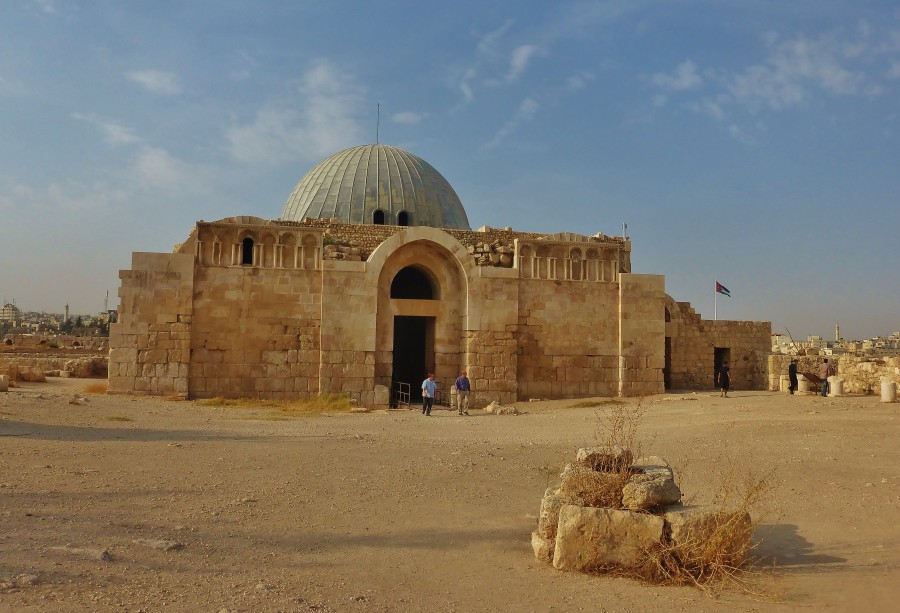
Amman; Citadel (Jebel al-Qala’a) – the Umayyad Palace. Jordan.
My last point of the tour was the King Abdullah Mosque , completed in 1989. It has two minarets and a blue dome with a volume of 35 meters, and a symmetrical pattern decorated with mosaics. The mosque can accommodate 7,000 Muslims inside and an additional 3,000 in the courtyard. Muslims were also so nice that they made a separate place for prayers for women who can hold 500 pieces. This mosque can not be confused with any other just because of the large blue dome that represents the sky. In the middle there is also a small Muslim Museum, where you can see the Arab art and pictures depicting King Abdullah I, although I think that first of all you should look up at the blue dome and gold lines representing 99 names of Allah. All symmetrical decorations were made by the Arab masters of patience. This mosque is also open to Christians.
When I returned I was already non, but in Amman I felt good and safe. First, I stopped in a cheap pub where I ate barbecued kebabs, and then I returned by taxi to Downtown for 2JD. Before going to sleep, I was still walking around the Roman Theater, I bought a few magnets for the fridge and ended the day with carrot juice. My two days in Amman have been very nice to me, although one should remember that there are many other things to see. There are more museums, mosques, night clubs and baths.
A one day trip to Jerash
Jerash is one of the biggest tourist attractions in Jordan, because there are well-preserved Roman ruins. In times of splendor, Jerash was the administrative, cultural and religious center of the region, which was also located on a very important trade route and had fertile lands around. All these things were extremely important to the Rzynski Empire, which from Jerash could promote its culture in this region and develop trade and feed the army. During the heyday of Jerash there were richly decorated amphitheaters, triumphal arches, temples built in honor of the Roman gods and then churches, as well as fountains, shops, schools, streets, baths and many other facilities. Gilead Highlands were a salvation for Jerash because in a desert climate it is difficult to find a living lands, and here, for example, were olive plantations.
When it comes to the time of the uprising, Jerash was created by ancient Greeks in the time of Alexander the Great (333 BC), but Jerash’s greatest development was experienced by the Roman Empire when General Pompey invaded the Jordan River basin in 64 BC. For the next centuries, Jerash only grew stronger and it was of increasing commercial importance, which was used by successive rulers of Rome. As a curiosity, let me say that Jerash traded, inter alia, with the Nabateans, the founders of Petra. Jerash began to lose its importance only due to Muslim invasions in the first half of the 7th century, and its last nail in the coffin was the earthquake in 747. Restoration work was begun at the end of the 19th century, which greatly facilitated the preservation of Jerash and its monuments.
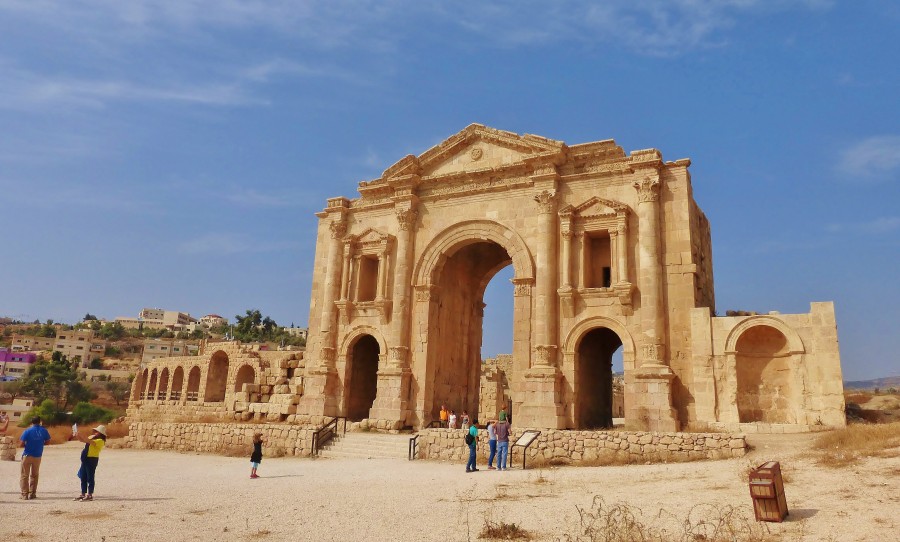
Jordan; Jerash – the Hadrian Arch.
There are many buildings in the old town of Jerash, but I will briefly describe the most important ones.Some have been preserved in a better way and others in a worse condition, but no matter what, it is a very educational move to the history of ancient Rome. Near the entrance is the Arch of Hadrian , also called the Arc de Triomphe. It is a massive stone building, 13 meters high, built in traditional Roman style. Once there was also a huge wooden door but to this day only the stone binding of the gate has been left. Right after the gate there is a Hippodrome , destroyed between the 1st and 3rd centuries. The hippodrome is a sports arena serving the Romans to horse-drawn carts, size 244, 50m. There are stones around to show that it was a huge place for the audience, although archaeologists argue that there were also stables and shops.
About 250m from the Gate of Hadrian is the South Gate , which is smaller but still attractive. It was built in 130. At this point, I advise you to pay attention to the walls surrounding antique Jerash, which are 3.5 km long, although unfortunately 24 defense towers have not survived to this day.
I think, however, that the hallmark of the ancient Jerash is the Oval Square , built in the first century, which is surrounded by 56 columns and occupies an area of 90m x 80m. In the middle there is a fountain added to Forum Square (another name of the square) in the 7th century and the ground is lined with limestone tiles. The Forum had many goals, and although some historians believe that it served the Romans for ritual slaughter of animals, in my opinion it was primarily a place of meetings, trade and exchange of political views. Oval Square also had a religious meaning, because on its southern side there is the Temple of Zeus (Jupiter), built in 162, on the area of 40m x 30m. Today, this temple is not complete because there is only a rear wall and a few columns at the front. The temple of Zeus is well visible from every place in Jerash, because it is located on a hill. On the one hand, this is a good solution but on the other hand it meant that it was more susceptible to erosion and earthquakes. This object gave me shelter from the sun, and you can buy tea and coffee on site.
Just behind the temple is the Southern Theater , which is the best preserved in Jerash, although until today only one row remained, although it was once able to accommodate 5,000 spectators. This Tetra was built in the years 81-96 and performances take place there today. When I visited Jerash, I saw Arabs playing instruments reminiscent of Scottish bagpipes.
As in every city, also in Jerash, attractive streets have survived to this day, decorated with Roman columns and what remained of temples, shops and baths. The popular street is Cardo Maximus , which is 800m long and stretches from Oval Square to the North Gate. You should also see the attractive Macellum square, also surrounded by columns and with a fountain in the middle, where people gathered for conversation. Walking through Jerash, I also reached the southern and northern Tetrapylon, which is, by definition, an ancient Roman monument with a cubic shape, with a gate on each side. Tetrapylon was always built at crossroads, and in Jerash it is the same because they are at the ends of Cardo Maximus.The North Gate, on the other hand, was built in 115 and it is not so attractive compared to the Hadrian’s Gate. There is also the North Theater nearby , which is smaller than the southern one, but still very attractive. It was built in wok 165, then rozbuyany in 235, so that it could accommodate 2,000 spectators.The North Theater has been very nicely restored and there are also performances, even though historians are of the opinion that the object was used in Roman times not for performing arts but for political meetings.
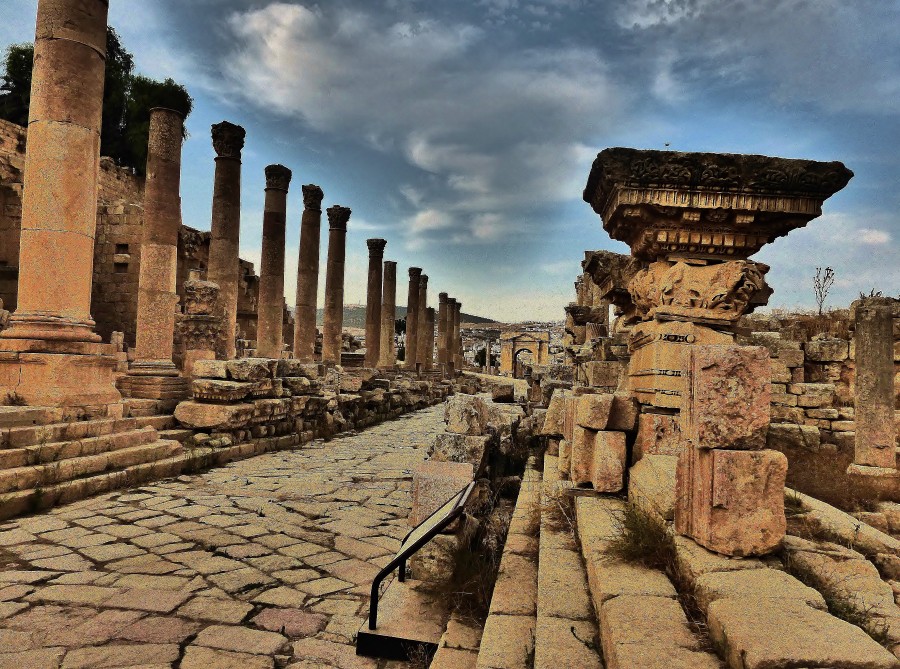
Jordan; Jerash – the Cardo Maximus street.
When in 324, in the times of Emperor Constantine, the main religion of Rome became Christianity, immediately in all cities of the Roman Empire began to build churches and cathedrals, and even competed with each other which city will have more impressive churches. As soon as Zeus, Hera and Poseidon came out of the grace of the people, the stones from the former pagan temples were used as building material for the new temples. So far, there have been found ruins of 15 churches in Jerash, the most famous of which is the cathedral of St. Teodor , built in the fourth century on the site of the former temple of Dionysus, as well as the church of St. John the Baptist .
All of Jerash is a very interesting encounter with history and every square, street and temple could tell its story and legend. In Jerash there is, for example, a square that I particularly liked. It is Nympaeum , a fountain built in honor of a water nymph, lined with marble and surrounded by columns. Sitting here I thought what a relaxing place it must have been. In a hot climate you could sit by the fountain, among the plants, and on the columns there was certainly a roof giving a salutary shadow. From there I went through Propyleum , a stone staircase at the end of which was a monumental gate, built in 150.
Just outside the stairs, one of the best-preserved buildings in Jerash, the Temple of Artemis , the daughter of Zeus, goddess of fertility and hunting, stands on the hill. This temple was built in the years 150-170, and in the sense that it is “well-preserved” I warn you that you can not expect miracles. To this day, the main square, the back wall of the temple and 11 of the 12 high columns have been left. It should be remembered that unfortunately, no object in Jerash reflects its former splendor as these are only ruins. The pagan temples were destroyed by the Romans themselves, who needed building materials to build churches, then they were destroyed by Muslims, the Crusaders and by earthquakes. When the Temple of Artemis was new, there were marble floors, carved pillars, Artemis statues and expensive materials, while only empty walls were left behind, which were used for workshops and shops. It is important, however, that we never forget about any of the civilizations and about the values they were guided by. Those interested can also see the small Jerash museum , where many items are excavated in this ancient city.
*
Jerash is located about 50km from Amman and getting there is not a problem. I got to Jerash from the dirty Abdala station for only 1JD, although there are also taxis on the spot, which is unfortunately more expensive. The one way course is around 15JD-20JD, but I was lucky, because after leaving the ancient city the taxi driver had one seat in the car and that’s why I paid only 10JD.

Jordan; Jerash – the Macellum Square panorama.
Expedition to the desert to Azraq and to “sand castles”
After visiting Amman and Jerash, I wanted to experience a desert adventure to feel the realities of the Arab country. For this purpose, I planned a trip to Iraq, to the town of Azraq, and then I wanted to see “sand castles”. So it was a touring trip. First, I went to a cluster of buses, proudly called the station, where there was only a lot of rubbish, it was loud and really obleśnie. Unfortunately, I did not immediately get to the place because first I got a shared taxi to the small Zarqa , where the station was even more grubby than the one in Amman. It was a chaotic and run-down bus station and bazaar in one. In Poland, this would be a place for a rubbish dump or for a ghetto for Gypsies, but in Jordan there are stalls with food and buses, and people spend most of their lives there. It is true that it is difficult to compete with Indian shit and chaos because this is extreme, but Arabs certainly have their place on the podium.
In addition, Zarqa is surrounded by heavy industry and serious environmental pollution, which is why it is famous for such attractions as heart attacks, cancer and coronary diseases. Going through the streets was risky, but people traded clothes and things even on the sidewalk in the middle of the road. The pubs serve kebabs and desserts, and the Arabs have a sense of humor and are curious about tourists. I advise, however, that after eating the local delicacies wait for a visit to the toilet, so as not to expose the suck in the desert. After about an hour spent in this special place I bought a ticket from 1.5JD and left Zarq without regrets, and during my 1.5 hour drive I saw nothing but the dry desert. I will add that Azraq is located about 100 km from Amman.
My bus stopped at Azraq , right in front of the castle, but when I got out I was a bit surprised, because I was expecting the city, and I saw only the workshop and the wind blowing the desert sand. On the way there was also a sign for the Wetlands Reserve, which is located a few kilometers from the center.However, I came here to see the castles on the sand, so first I went to the Azraq castle, where for 1JD I bought a ticket entitling me to enter the area of 3 castles. Azraq Castle is located in a very strategic place because in its vicinity there is an oasis with a permanent source of water.
In a radius of 12,000 km² of dry desert, Azraq is a gold mine because water is the most valuable treasure in the desert. It was for this reason that the Romans built a castle here in the fourth century, and over the following centuries there were continuous conquests and many people gave their lives – just to get water. Azraq Castle is built of massive basalt boulders of black color on a square square with an 80m side. The castle is even well preserved, and to this day you can see its fortified walls, a huge gate, chambers and powerful observation towers. Azraq Castle is a popular one-day trip from Amman, although I’ve been here alone and I think it’s better this way.

Jordan – in front of Azraq castle.
Then I boarded a small bus going towards Zarq (0.5JD) and after about 20km I got off at the fork in the road and stood on the road to Amman. In front of me was only a dry desert, trucks pushing the sand in my eyes and road signs to Saudi Arabia and Iraq. Of course, I tried to stop a car but it was not easy because the Arabs were driving through the desert to break the neck. I felt that I had to start moving because it was hot and dust. However, I was cautious because I had with me 2 liters of water and food supplies and a tent, because I planned to sow a night in the desert near the road. After some time, however, finally the truck stopped, which brought me to Amra.
Amra Castle is the most famous of the desert castles of eastern Jordan. It was built at the beginning of the 8th century, between 723 and 743 by Walid Ibn Yazid, the future Caliph of the Umayyads of Walid II, and is the remnant of a larger complex. Amra Castle is small but also the best preserved of all castles, not only because of the well-preserved structure of the building itself and its stone domes, but also because of the internal paintings depicting the rulers, naked women, and hunters. Amra Castle is one of the best preserved examples of early Muslim architecture and is located about 85km from Amman. After visiting this object, I returned to the road where I found another hitchhiking quite quickly. This time I was driving a small passenger car to the Kharana castle.
I liked Kharana Castle the most, because of its size, interesting architecture and lonely location in a flat desert. Kharana Castle is located about 60 km from Amman, relatively close to Saudi Arabia. It is built on a square square with a side length of 35 meters, has two floors with 60 rooms and has a very attractive main gate and round towers on the corners. In addition, the Kharana castle has tiny windows adapted for use by archers and sophisticated patterns on the walls. The main courtyard is empty but well preserved. I advise you to watch out for the stairs and have a good look at the rooms, with their patterns and columns built into the walls. Kharany Castle was estimated for 710, which in my understanding means that it comes from the first half of the eighth century, and the year 710 should be treated conventionally. Unfortunately, it is not known for what reason this castle was created, and whether it was really a fortified castle, or maybe just a caravanserai, a shopping center with rooms in the desert. I suspect that this object had many destinies.
That day I did not eat anything yet, it was already late, so I stopped in a big tent about a local vendor, where I ate a can of tuna with bread baked on the fire, and I got tea, also from fire. The price of 5JD was also 10 postcards, which I gladly took. With the Arabic seller I have moved traditional topics such as family theme, number of children and my work. Near the Kharana fortress is a good place to camp , so I could set up a tent there and spend the night, but decided to move on, because the ground was very hard and stony. The food seller was just returning to Azraq, so he only took me to the main road, from where I was going through the desert to find a good place for the camp. It was already dark because I didn’t want to spin too long. I saw that they were building a road ora, there was heavy equipment, and I wanted to find a secluded place. So I walked further along the sand, lighting my way with a flashlight, until I finally found a place by the tree. I threw my paws out into the Jordanian desert, fastened the flashlight to the tree, and spread the tent peacefully and then I went to sleep tired. It was a cold night but it was bearable. It was not as cold as a few years ago in Kazakhstan , then in Lebanon and Azerbaijan . This time, in Jordan, I felt good and from time to time I heard passing trucks, and in the morning, when the sun rose, it was very hot.However, it was hard for me to get up from the hard ground, so I got up only about 10 and only when I drank 0.5 liters of water. Then I changed into my daily outfit, put up my tent and slowly moved to the main road.
I quickly got to another hitchhike, and this time I bought a yogurt merchant to the ancient Hammam al-Sarah bathhouse. As the name suggests, it is a bathhouse, where dome domes on the roof have been preserved to this day and channels through which water has entered the indoor pool. Once there was also a garden here, so that water flowed through the canals outside and irrigated the plants. This bath is currently undergoing thorough restoration work and it was built between 724 and 750. Certainly not later because the al-Sarah bathhouse is a Umayyad building, whose caliphate was conquered in 750.
About 3.5 km from the bathhouse is the Hallabat castle , which was built by the Romans in the second century.This object is partly complete, although it is rather a complex of chambers with arches and a courtyard, a bathhouse, a mosque and an agricultural room. The castle was built to defend against Muslims, but after the fall of the Christians and the castle was taken over by the constantly advancing Muslims, this object changed a little. Here, where the chapel was a mosque, and the mosaics have been slightly changed to Muslim. This Roman fortress standing alone on a hill, built of limestone rocks, looks very attractive against the background of the desert. I also think that in a few years these last two objects will look much better because the restoration works are taken very seriously here, not only by Arabs, but also by groups of archaeologists from Spain.
By the way, for those who want to see more “castles on the sand”, I recommend the al-Mushatta castle , located near the airport in Amman. I mention this so that travelers departing from Jordan devote time to one more castle, which is very well located.

Jordan – lonely desert wolf in front of Hallabat castle.
When I got to the main road, I caught another hitchhiking to the main road, and then, on board a bit of a newer bus than the desert castles, I drove 30km to the full rubbish and chaos of the station in the city of Zarqa. I liked this ride because I drove through the sand covered with dirt, bypassing the loaded trucks, and I also knew that my trip was successful because I saw everything I wanted. At the train station in Zarqa it was also very nice, because in the local pub I was served grilled meat and I was also an attraction of the pub. People had many questions because they had not seen white for a long time. Then I got on a bus going to Sabah, but after about 0.5h of driving I got off at a fork in the road going towards Amman. After about 10 minutes walk I turned right, up the hill and first walked to the mosque and then to the Cave of 7 Sleepingwho have their graves there and who were also mentioned in the Koran. Legend has about 7 boys who were persecuted by the Roman emperor Trajan, and therefore they fled to the cave where they slept for 309 years. Inside the cave there are their tombs, including one with a hole through which you can see human bones. Nearby are also the remains of two mosques and a cemetery from the Byzantine times. Well, I like places like that, although on that day there were so many people that I was not able to take good pictures.
After all, I hitchhiked to the local bus, which for 0.5JD drove me to Downtown, near the Roman Theater, where I lived. I felt tired, but also happy that I had this desert expedition in this way. There are tourist offices in Amman that can take tourists to all these places, but in my opinion it would be an adventure.
One more day in Amman
That day I planned to go to Madaba, but it was Friday and that’s why the transport was very limited. So I did not want to bother at the station and look at the top of the trash. Instead of waiting indefinitely, I devoted this day to see Amman better. That day I was not in a hurry. I was once again at the Roman Theater, I saw Odeon and I was on several good snacks away from the old part of the city. I went to the bazaar to drink tea to observe people in their daily activities, and came to the conclusion that I liked the tradition of Jordan most, because I miss the European tradition in European countries. Observing Arabs living in accordance with their culture and tradition, I understood how sad it is that England is no longer England and Sweden is not Sweden. Well, the European sheep are becoming more and more stupid each year, while the Arabs, despite continuous invasions, do not give up.
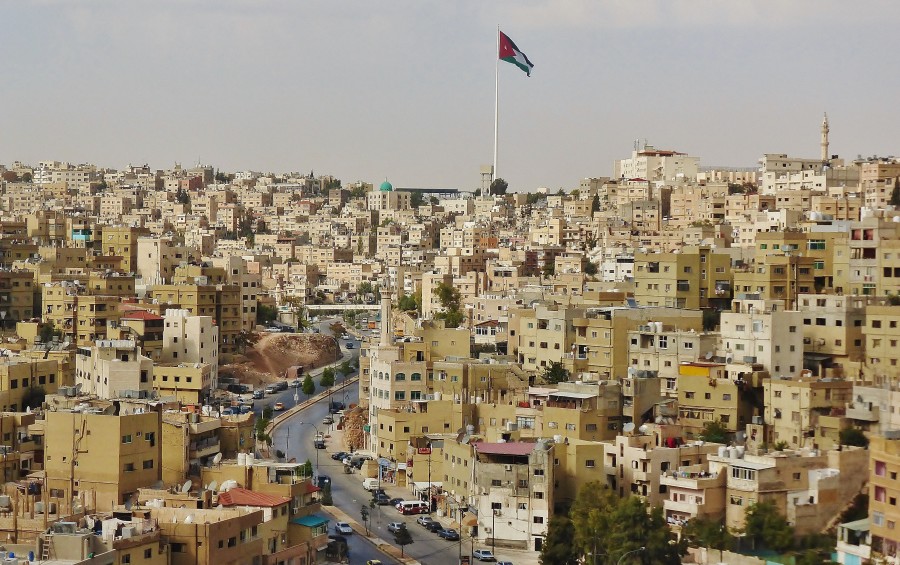
The panorama of Amman seen from the Citadel. Jordan.
Whilst walking through the streets of Amman, I saw many bookstores and came to the conclusion that there is more freedom of speech in Jordan than in Europe. The Jordanians were selling books about Jewish financiers responsible for wars in the Muslim world. I also saw books about Zionist domination of America, Jewish Wall Street, Jewish media, and the terrorist Israel. With all these things, I agree, especially since the Jews have confirmed this many times, and on these topics there is an avalanche of evidence. I also saw Adolf Hitler’s “Mein Kampf” in the Arabic and English versions, which is the most popular book in Jordan after the Koran. Unfortunately, I saw only one, and the last English copy, because the rest was bought by European tourists. I decided not to buy because there were too many mistakes in printing. Anyway, knowledge is a strenght, that’s why I recommend “Mein Kampf” – as a timeless, historical literary masterpiece.
Transport from Amman to Madaba
I went by bus for 1JD, and the trip lasted only 1.5 hours. The distance between Amman and Madaba is only 32 km. The ride should last about 50 minutes, but taking into account that the bus departs when it is full, it lasts twice as long. The views during the ride are boring, and at the entrance to Madaba I was greeted by a sandstorm, which was the only attraction of my tour.
Madaba – “the mosaic city”
Madaba is a very nice small town, which is very popular because of the Christian mosaics from the Byzantine times, which are located in several impressive churches. About 30% of the population of Madaba are Christians, which makes the city have its own specific charkater. In addition, Madaba is a very good base for nearby attractions such as the church of Mt. Nebo, the Dead Sea and the ruins at the top of Mukawir. I think Madaba and the whole area are very valuable, both historically and because of natural beauty.
As soon as I arrived at Madaba, I first stopped at the station to drink tea and look at the top of the trash, which unfortunately was there. I realized that while Jordan is a very interesting and valuable country, dirt is an inseparable companion of Arabs. Well … When I left the bus station again I saw a mess, rubbish, vegetable stores and chaotic traffic on the street. Then I wandered around the city with a heavy backpack until I arrived at the cozy Fadi’s Home Stay hostel, for only 5JD. As it turned out later, I stayed there for 3 nights because it was so nice. On the first day I concentrated only on visiting Madaba and of course the main attraction of the program were antique moizacs in churches and very interesting workshops,where I saw how craftspeople make mosaics on the walls in the form of paintings. I saw the artists had carefully cut stones of different colors and then put them into a beautiful whole. Sometimes they are landscapes, animals and plants, and sometimes symmetrical patterns of many colors. Very popular is for example “Tree of life”, which shows peace on one side and brutality on the other side of the tree. On one side roe deer graze in peace, and on the other side roe deer is attacked by a lion. I think that the mosaics, both in the workshops and in the churches, are a great attraction of Madaba, although you can also eat very good Arabic food there and do shopping at the bazaar, which is a paradise for the traveler and for the psychologist.
I want to say, and it should be taken seriously, that Madaba also has several ATMs close by, and that’s why before heading to other parts of the country, the money should be drawn there and exchanged into smaller ones. Madaba is also a great organizational base.
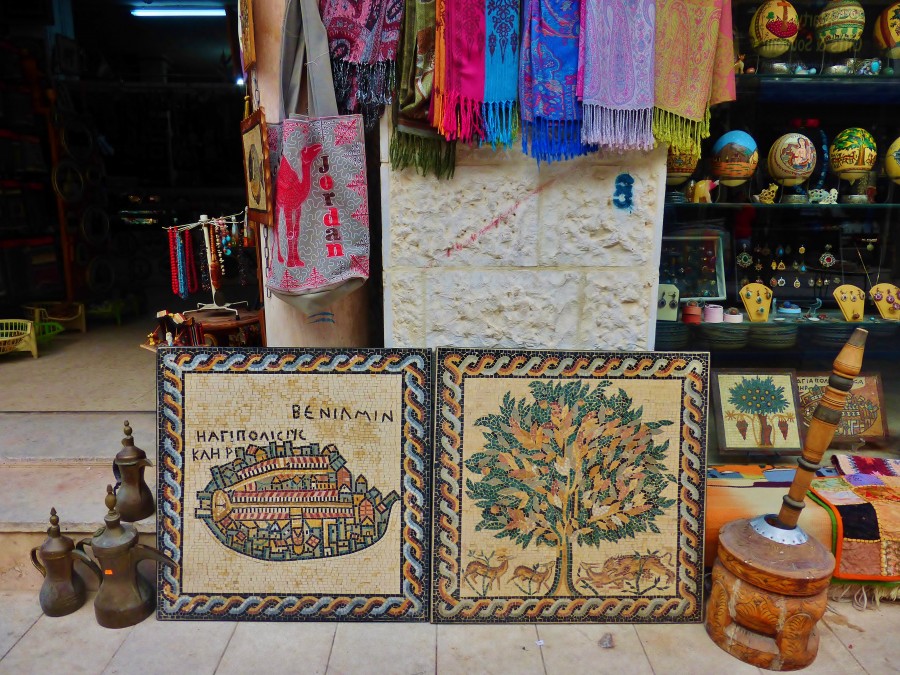
Jordan; Madaba, and a souvenir shop. Please take a look at the “Tree of Life” on the right.
The Church, which should not be missed is the church of St. George , where there are the best preserved Byzantine moizaiki. Greek church of St. George was built in the nineteenth century on the ruins of the Byzantine church. The new church in this place was decided to build due to the mosaic map of Palestine, which to this day has a huge historical value because the places are not seeded. Thanks to the map historians were able to learn a lot about the history of Palestine and part of the Middle East region. Now the church and the mosaic are in good condition and are prepared for tourists, historians and faithful Christians, but I personally always try to imagine the places I visit in the way they used to be. It must have been an amazing discovery when such treasure was discovered under piles of debris. This map was created in 560 and contains 157 marked places in the biblical region of the Middle East, from Egypt to Palestine. Historians have come to the conclusion that the mosaic was originally 15 m to 25 m long by 6 m wide and was composed of 2 million stones. Unfortunately, a small part has survived to this day but there is still so much that you can learn a lot about the history of Palestine. In the church there is also a shop with a copy of the mosaic map and orthodox icons of saints. I paid 1J for entry.In addition, I advise you to come here early in the morning because then there is always a lot of people and it’s hard to see something.
Then I saw the Archaeological Park and the church of Mary. The whole object is a complex of mosaics, a museum, Roman columns and the church of Mary built in the 6th century. In the church, of course, there is another mosaic, this time from 767, which is a geometrical work. Immediately after the entrance is a mosaic of Mukawir, which is the oldest in all of Jordan, since it dates from the first century BC. Next is a mosaic depicting the church of the prophet Elias, from 607. Attention should be paid to the large green bird. Next is the Hippolytus Hall, which was a Byzantine residence built in the 6th century. Not much remains of its splendor, but to this day you can also admire interesting mosaics depicting plants and the Greek tragedy. On one of the notes is also Aphrodite with bare breasts.
I also recommend the Catholic Church of John the Baptist which is very attractive, if only because of the attractive exterior wall and the tower that I entered to observe the city panorama. This church is further away from the center and it was built in 1910-13 on the ruins of the older church. On the front wall there are several attractive saints’ mosaics, including Jesus, very impressive crosses embedded in the wall, and low Roman columns. In the middle, there are wonderful paintings and mosaics, and what does not happen often, you can see here Christian paintings bound in Arabic script. In addition, there are also Italian paintings on the walls depicting John the Baptist, and the sanctuary of John the Baptist with subsequent mosaics, with the plan of the old Madaba and over 100 years of photographs. Very interesting.At the end, I climbed the bell tower over the uncertain steps to see Madaba’s panorama. The church of John the Baptist should be treated as an important find of the traveler.
Not far from there is also the church of the Apostles , with another magnificent mosaic on the floor, depicting birds, crosses, geometrical patterns and the Greek goddess emerging from the sea from 578. I liked the church itself too, because it was fortified, and there were thick stone pillars inside.
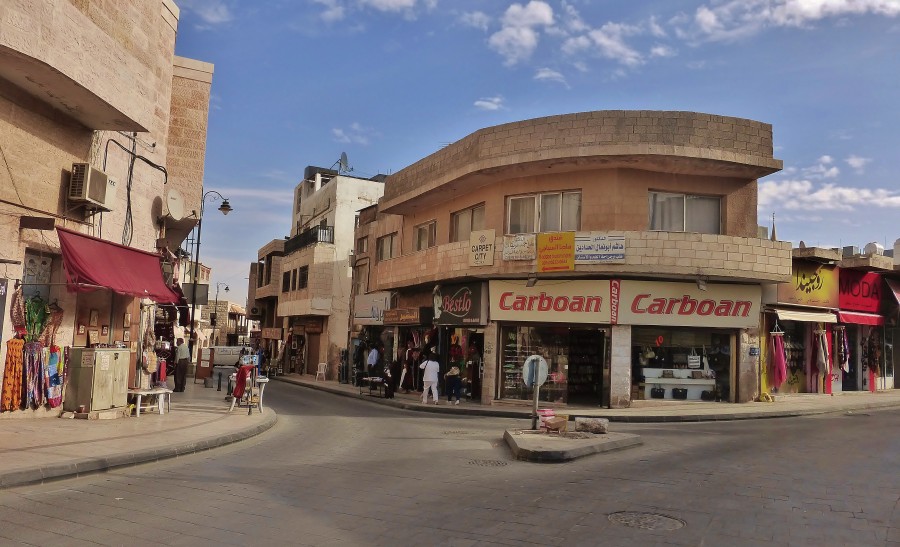
Jordan; a street in Madaba (the “mozaic city”.)
Although the panorama of Madaba is dominated by the huge mosque of King Hussein , with a large golden dome and two high minarets, tourists visit Madaba not because of Islam but the history of Christianity. Interestingly, in 2008, Muslims built a Mosque of Jesus Christ in Madaba, because one of the Imams had the idea that mosques around the world are called names of prophets, while in Jesus in Islam is also a prophet, so to bring Muslims and Christians closer together who make up 10% of the Jordanian population, there is nothing wrong with naming a mosque named Jesus. Besides, I was walking around Madaba and I noticed that people were very curious about where the white tourist came from and 2 times I got an apple as a gift. They greeted me in Jordan. In Madaba, I was well and I remember this city and its people nicely, but my trip had to go forward.
A trip to Mukawir – and adventure in transport
The next day I decided to go to Mukawir, that is to the Roman ruins on the top of the mountain, with beautiful views of the Dead Sea. First, however, I would like to describe my adventure in transport, and then I will say about the object itself.
I went to the Madaba bus station, where I took some pictures of old trucks, interesting people and rubbish.At the so-called “station” I was early in the morning, and after I had smoked all the smokers on the bus, I waited patiently for the departure. The weather of the day was rainy, and after I waited 0.5h, I was given to understand that there are not enough passengers and the departure will take place in about 1h. So I went to the main route and a few hitchhikes I went 30km to the exit to Mukawir. From there, however, was another 12km to the village of Mukawir and the next 5km to the observation point, where the route uphill to the ruins at the top begins. From the side exit, I was picked up by Beduin with my 35-year-old robbery for 5JD, and the last 5km I went on board the next car for 2JD. Especially in the last phase of the ride was very nice because I had mountains around. After a while, I started my climb to the top, and this time the weather was also better.
There are several roads to Mukawir, but in my case it only depends on luck how long my route will last.
Mukawir is a fortress built in 90 BC, strategically placed on the mountain. It was an important stronghold and a vantage point to warn allies in the event of an attack by enemy armies. Nevertheless, Mukawir was conquered in 57 BC, but in 30 BC the fortress was rebuilt by Herod the Great and served as a military base.Herod fortified Mukawir even harder but over the years it did not help much because this important strategic point was a field of many battles and many times fell. The Jews conquered Mukawir in 66, but the Romans captured it six years later. Mukawir stands at an altitude of 1100m above the level of the Dead Sea and is surrounded by ravines on all sides, which makes it the protection of the terrain. In addition, Mukawir is also known for the two-year prison and execution of John the Baptist in 32 (Mark 6:24 and St. Matthew 14: 8). Mukawir is therefore a biblical building that refers to such biblical characters like John the Baptist, King Herod and Herod Antipas, to whom Mukawir belonged from the 4th century BC to 39.
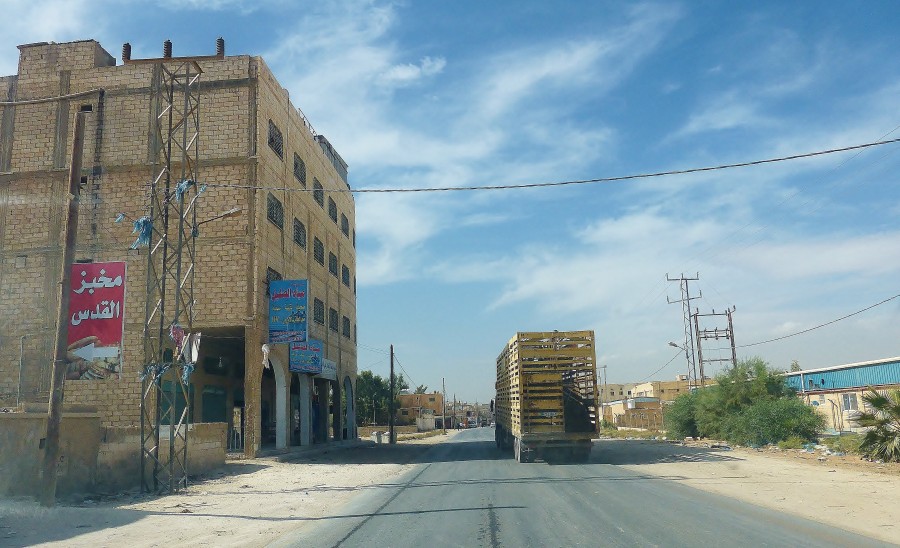
Travelling through the desert my way. Jordan.
Despite the heat, climbing up to the summit gave me a lot of pleasure because I felt that I was in a unique place. Unfortunately, at the top of the mountain I did not see the fortress but the ruins on the square 100m x 60m, the bases of the walls and a few columns. This is unfortunately all that is left of the Mukawir fortress. I admired the beautiful views of the Dead Sea and Palestine on the other side of the shore from there.
I came back to the main road with a tourist coach with a group from India and then, a few more hitchhiking, I returned to Madaba. At the hostel an American advised me how to get to Petra for free, to save 50 euros. I also came to the conclusion that it was nice to talk to a white face with which I did not have a language barrier.
Day trip to Mt.Nebo, to the baptism of Jesus on the Jordan River and the Dead Sea
My next day I went to Mt Nebo , only 3 km away from Madaba. The taxi cost me 2JD. Mt Nebo is located on the highlands, about 800 meters above sea level, which was mentioned in the Bible as where Moses saw the “promised land” before his death, and where he heard from God that “he will not come in and die on the hill”. Moses was later buried in Mt. Nebo or in its vicinity, but neither Christian nor Muslim sources will know where. During good weather, visitors can see the Dead Sea, the Jordan River and the outline of cities such as Jericho, Bethlehem and Jerusalem from the observation deck. When I was standing by the board on which directions and distances were marked to each of these cities, a Jordanian policeman approached me and said that “Palestine would be free one day”. I felt that the view of occupied Palestinian cities was very emotional for the Jordanians and that the Arabs would never give up.
Today on Mt Nebo there is a basilica, which when I was there, in 2015, was closed for renovation works. In this place one should pay attention to the memorial monument of Moses, and to beautiful mosaics inside the basilica depicting animals, plants, people and geometrical patterns. This basilica was built in the fourth century in honor of Moses, and was expanded in 597. On the observation deck, where there is a board with directions and a panoramic view of the Dead Sea, there is also a cross with a “cynical snake”.
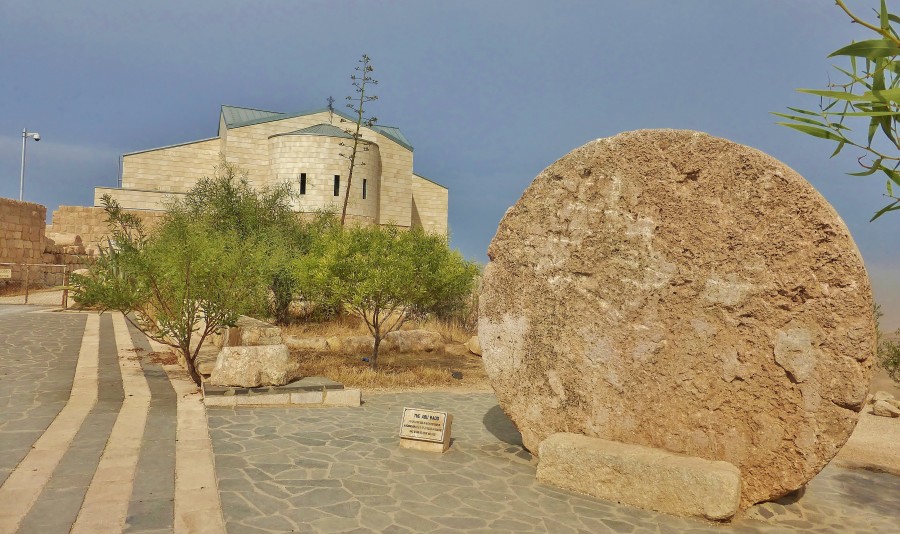
Jordan – Mt Nebo.
In 2000, Mt Nebo visited, among others, the Polish Pope John Paul II, during his tour of the Holy Land, and planted an olive tree near the Byzantine chapel, as a sign of peace. Then in 2009, the German Pope Benedict XVI visited Mt Nebo. I also advise visitors to spend more time not only in this very romantic place, but also recommend that you climb to a few heights and see the basilica and cross from many parts of the world. The whole object is built of the color of the desert and therefore fits well with the surroundings.
My next plan was to cross the mountains and get to the Dead Sea and the Jordan River. Taxis in Madaba take about 25JD – 30JD for this service, which I think is not a great expense if you travel in a group, because you can share the costs. However, I am always alone, which is why I relied on hitchhiking. Being in Mt Nebo I was lucky because I met a pretty Chinese woman traveling in a good car and took me through the mountains to the main route in the valley. The views were of course very picturesque because we were driving through small mountains separated by small ravines, and at the end of the route we drove into the lowlands to the Dead Sea. The Chinese woman was going to see the place of the baptism of Jesus, but I got off at the crossroads and the next hitchhiking I got to a big shopping center so that I could finally take out the money from the ATM.
For a short time I walked along the Dead Sea, observing the neglected, dirty shore, but soon I got to the Jordan River. As soon as I got off the road, the weather broke down badly, because suddenly a sandstorm hit me, which brutally turned palm trees in all directions and made the road invisible. Only clouds of sand floated in the air and I do not think anyone would even see me standing in the way. Anyway, in such weather conditions it was dangerous. This time I was also lucky because after reaching the road to the place of baptism, another gratm stopped, which had goats in the back and two Arabs in the front. However, they took me inside and in this way I defeated my last kilometers. For some time I was still wandering around but soon realized that it did not make sense. I had to wait out the storm.
When the storm stopped, I bought an admission ticket for 12JD to the place on the Jordan River, where Jesus was baptized by John the Baptist. Colloquially, this place is referred to as the Place of the Baptism of Jesus . It was the best place so far. We took a bus to the border zone and then walk to the place of the baptism of Jesus. Then we went all stupid to the Jordan River, which is the natural border between Jordan and Israel / Palestine. I saw here whole baptism groups that came from Israel. It is important to remember that the Jordan river bed in this place is relatively narrow, so it would be easy to go to the neighboring country, however, the Israeli-colored tanners give only one warning and then shoot. Putting rifles aside, I think that the Jordan River here is a very moody place visited by pilgrims from all over the world, including by popes, and people who are immersed in the name of God are experiencing this very much.
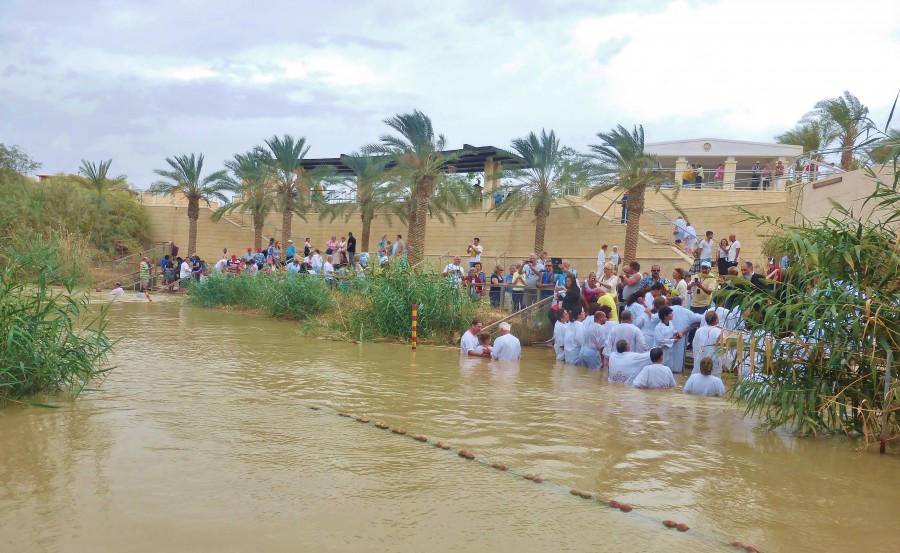
Jordan river, which is a border between Jordan and Israel. Please take a look at the border on the river and people who went there to be baptised.
According to the church, this place is as authentic as the testimonies of the gospel and the testimonies of pilgrims and travelers who visited this precious place centuries ago. The discovered archaeological findings and related research show the last remains of five churches uniquely designed and built from the 5th century, which are mementoes of the baptism of Jesus. In addition, the authenticity of this place as the baptism of Jesus is marked on the map of the mosaic of the Holy Land.
Then Jesus came from Galilee to the Jordan to be baptized by John. But John tried to deter him, saying, I need to be baptized by you, and do you come to me? Jesus replied, Let it be so now; it is proper for us to do this to fulfill all righteousness. Then John consented. As soon as Jesus was baptized, he went up out of the water. At that moment heaven was opened, and he saw the Spirit of God descending like a dove and alighting on him. And a voice from heaven said, “This is my Son, whom I love; with him I am well pleased.”
The Gospel according to Saint. John (3: 13-17)
On the way to the Jordan River there are also several important objects to pay attention to. At the turn of the 5th and 6th centuries, the church of John the Baptist was built here. Then, in 570, a marble staircase was built in the direction of the Jordan River. In 670, a small chapel was built closer to the river and a pool for baptisms, fed with water from the river. In the following years, other temples were added, which unfortunately did not survive to this day, among others, the Lower Basilica and the Church of Sts. Trinity, where today under the roof you can see the ruins of the floor and parts of mosaics. It is also important that Christians know that Jesus was not baptized in the Jordan River, but near the river, near the ruins of the last chapel.
I will recall the words spoken by Russian priest Daniel during his journey through Palestine in 1106-1107: “The place where Christ was baptized is far from the river as far as a man can cast a small stone.There is a small chapel with an altar. This means the place where John Precursor baptized our Lord Jesus Christ . “
My next goal was the Dead Sea . I knew that it would not be his best part and that the weather could be tricky but I wanted to swim in it. Two hitchhikers got to the seashore, but I was disappointed because the beach was unprepared for such a respectable guest as I was, and besides, it started to rain. When it comes to a downpour, it was not a problem for me because the water in the sea is so wet so what a difference for me if I get wet and up. I found dirt to be a bigger problem. Before I got to the shore, first I had to go through the mud, piles of rubbish and broken barracks. It seemed like a dump in this place, it was so dirty. There was also a Jordanian on the beach, pointing his finger at the rubbish, repeating “Arab” in disgust. I saw that he wanted me to understand that not all Arabs are dirty people throwing trash around.
Nevertheless, I walked into the long-awaited Dead Sea for a long time, and then lay down on its surface and floated limply like a rubber duck. The rain, on the other hand, proved to be very helpful, because it spilled mercilessly into my face, but it also removed the excess salt. After about half an hour in such wonderful conditions, I dressed in sand and salt, soiled, and then returned to the main mud road. Not immediately, however, I was looking for hitchhiking. First, I wandered around the desert and stood under the tree to caress the camel and look at the herd of goats. I will soon arrive, however, that I only had 1h until sunset and I had to quickly find a car going to Madaba, so I would not have to sleep in the desert and wait for the wolves. Again, however, I was lucky because I hitchhiked through the mountains to Madaba. In the rain, soaked, dirty and tired, but still I managed to bring my trip to the end, and saw everything I planned. One of the drivers praised Islam very much, and because he did not speak English, he only said “Islam good” and the rest he he spelled out with body language. Because he didn’t understand me anyway, I told him that I was a descendant of the Crusaders and that I was very proud of it. In this atmosphere and in “full understanding” I got to Madaba.
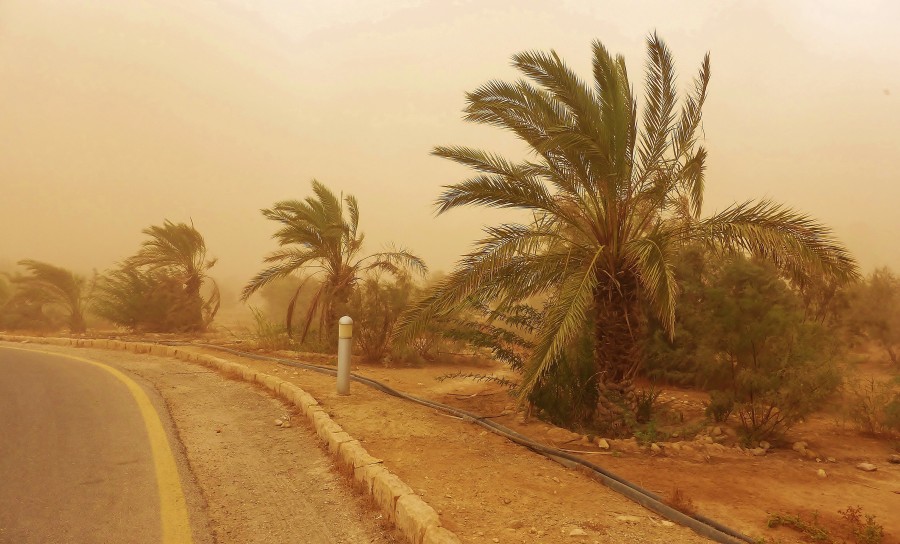
Sand storm in Jordan.
When I got to the hostel, I immediately took off the wet, armored with mud and sand, and then began to appreciate ordinary things, such as a shower, bed and a cup of tea. It was definitely a good day, but also very heavy and requiring a lot of commitment. Before bedtime, I also had a cup of chamomile tea, which I bought in Amman and with beautiful memories ended my adventure day.
Adventure in transport from Madaba to Karak
My whole other day passed me very curiously, even though I tried to get to Karak all the time. The beginning of the day was easy because by bus from Madaba I got to Dhiban for only 1JD, and the journey took only 1 hour. Dhiban is a small, uninteresting transport hole where bored Arabs sit at tea and smoke cigarettes. When I went there, I immediately became a city attraction because whites rarely see there.Everyone wanted to talk to me and shake my hand, even those who did not know English. In order to give me peace, I went to eat a falafel at the pub for 1JD, but as soon as I left, the young Arabs immediately rushed to me, slowly becoming intrusive and trying to touch me to see how white was built. Unfortunately, there is no transport from Dhiban, so I had to rely on hitchhiking, which was not there. Someone suggested that he would take me a few kilometers for 30JD, and then for 10JD, but I was not interested. Instead, I paid 1JD for anyone who had a car to take me 3km out of town. I felt that it was a good decision because it was the only way I could get rid of the intrusive Arabs. Then, in loneliness and peace, for about 30 minutes I waited on the road in the middle of the fields, where I watched the flock of sheep and the herding dogs guarding them, waiting for the car.
Soon however, the car took me, although at my own request I got out on the Mujib dam , from where there were picturesque views of the water luster on the background of the mountains. I spent some time on the bridge walking and taking photos. The Mujib dam was put into use in 2004, after 6 years of construction, and has enormous value for the poor in the Jordanian water, because it is a reservoir of desalinated water with a volume of 35 million m³. Then I got into another hitchhiking, which transported me through the Wadi Mujib mountains. I regret that I stayed for at least 2 days because it is a canyon with a unique natural beauty, with waterfalls and a river that feeds the Dead Sea at an altitude of about 420m below sea level. I planned to go to the Dana Nature Reserve, so I did not stay at Wadi Mujib , but from the perspective of time it is a poor explanation. I asked my driver to stop on the route, at the highest level, where there is a pub. From that summit I had a very good view of the Wadi Mujib mountain streamers, the water and the dam down below.
Then I managed to get another hitchhike, which I got to the small village of Al – Qasr, consisting of one road and several houses. With Al – Qasr, I took a bus for 1JD to the village of Al – Rabba , where everyone was very excited about the sight of white in their city. The Arabs in this city spoke poorly in English but had good hearts. I got tea as a gift and a cup of fresh water.Unfortunately, the situation soon became very tiring for me because a group of young Arabs got on the bus, which gave me no peace. They searched for contact with me, laughed at what they were trying to talk to me in Arabic, which of course did not make sense. So I had no choice but to make them shine, and in this way, after about an hour of driving for 1JD, I reached Karak. The driver was nice enough to drop me off at the Cairwan hotel, where I had a reservation and from where there was a view of the castle.
Karak
Karak is a small city with a population of over 20,000, which was included on the Jordanian tourist map, only because of the castle built by the Crusaders in 1142. Pimimo, that the castle is ruined in many parts, it has a strategic, almost proud location on a high hill, and looks spectacular on the horizon. For this reason, there is, of course, a bazaar nearby, a detour seller offering everything more and less needed, but there are also restaurants and shops. Thanks to the castle built almost 900 years ago, Karak is still full of life and its economy is supported by tourists from Poland, and not only. In addition, Karak is also a very good base for the Dead Sea, which I also used because I went on a trip there.
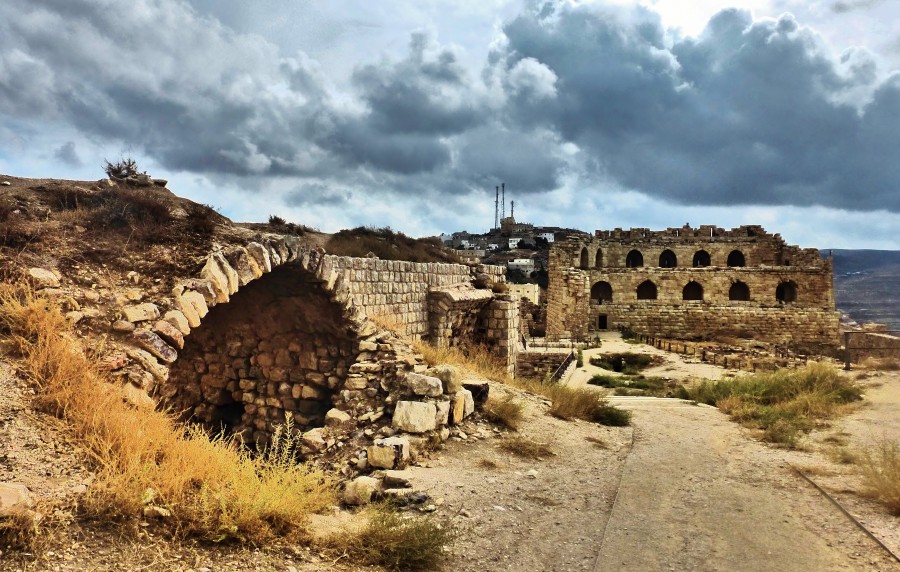
Karak castle, seen from the inside. Jordania.
Organized trips usually stop the coaches in front of the castle for about an hour, after which the tourists walk around the castle and drive to Petra. I, adventure traveler of course, organized my time in Karak much better, because I think that organized tourism is for school trips, for lazy people and pensioners. Probably because Karak is not often used as accommodation, hotels are more expensive there than in other, more often visited places. In Amman and Madaba I paid 5JD, while in Karak 17JD. I advise you to book them first, as prices can be as much as 30JD. I lived in a Cairwan hotel where I had a poor room and a shower in the basement, but that was all I needed. On the first day, when I did not want to go to the castle a few kilometers uphill, someone picked me up from the road to the gate for only 0.5JD.
Karak Castle is an adventure with history, where you can feel like a fortified fortress, destroyed after the battle. This castle is not in good condition but still there are many elements worth visiting. There are corridors, underground passages, arches and vaults, geometric bas-reliefs, and walls on which there are traces of battles. In addition, there are also panoramic views, but I think the most important thing is the castle itself. For centuries, its strategic location has been used to control the Bedouin trade route, though not only. Karak Castle was at the crossroads of trade routes of Egypt, Syria and Arab Peninsul. This strong position of the Knights of the Cross was, however, threatened at all times, as the growing armies of the “religion of peace” regularly attacked the castle, which caused the Crusaders to put more and more emphasis on its fortification. Karak Castle was controlled, inter alia, by the Ayubid dynasty, Sultanate of Mamluk and by the Ottoman Empire , and that is why today you can find various architectural styles, such as West European, Byzantine, Arab and left after the Crusaders. Many parts of the castle were destroyed in battle, and other rocks were removed because they had potassium nitrate, needed for the production of gunpowder. The good news, however, is that maintenance works are underway in Karak and that the original plans of the castle built by the Crusaders have been found. This means that there is a real chance to rebuild the castle in a similar style to that from 1142.
As a curiosity, I will also say that Karak’s castle was also on the set of 2005 “Kingdom of Heaven”, which tells the story of the Crusaders’ struggle with Muslims – and what I think lasts uninterruptedly to this day, despite the fact that it is now happening through international Jews. The film itself, however, I highly recommend.
Apart from visiting the castle, my two days in Karak have passed me very nicely. I was of course in the bazaar, in a good Arab restaurant and I drank tea with locals, with whom I made contact depending on their level of English. Sometimes it was easy and pleasant and sometimes the conversation turned into strong political and religious arguments.
Walking around after dark, I stopped for tea, where I had an interesting conversation with the Arabs about Islam. As it turned out, the opinions of the Arabs were not a surprise for me, because I only confirmed that the Arabs are professional liars who are able to cover up all crimes of Islam and Mohammed for deceiving the unbelievers, and once again confirmed in the opinion that the Koran is the only book the Arabs read.There are many quotations in the Koran confirming the fact that Islam is a military, brutal ideology with a religious component in order to control Muslims within the limits of its own psycho-regime. The Arabs in Karak were unable to answer my arguments about Muhammad’s sex with a 9-year-old and stoning women. They only stated vaguely that “if their prophet so ordered, it must meant something good.” We did not agree on religious matters at all, but we agreed about the war hungry, satanic Jews and the occupation of Palestine. At the end we shook hands in a diplomatic tone and I left. Let me remind you that I was in Jordan, it was a dark night and I was alone, and that I had that honest conversation in such conditions.
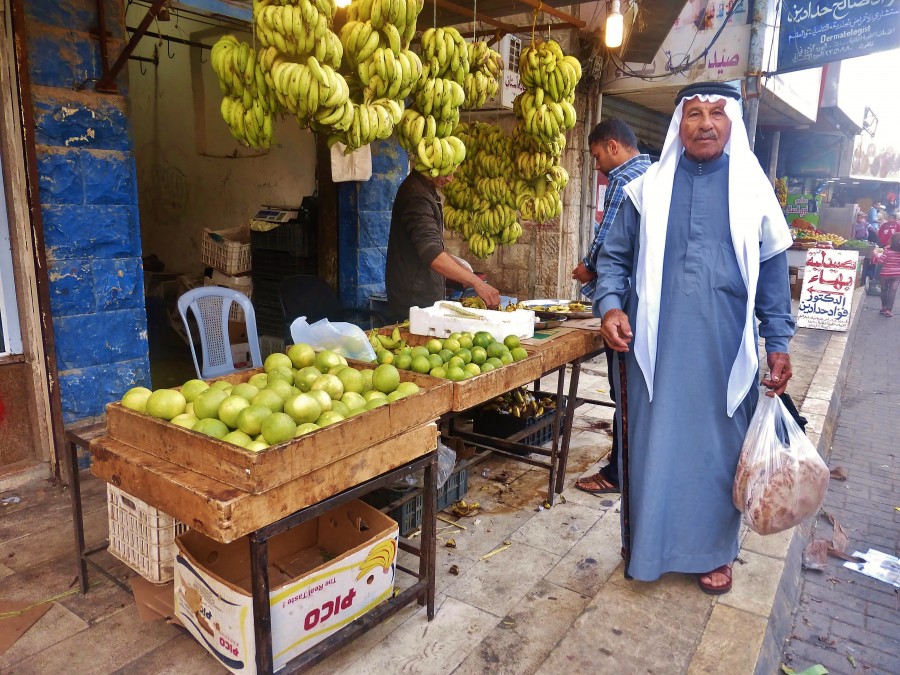
Arab man at the Karak bazaar. Jordan.
Then I went to the Internet, where immigrants from Yemen told me about the terrorism of Saudi Arabia in their country, about how the Saudis, the same who live in the “holy land of Muslims” are led by Zionist Israel, at their command helps to destroy the Arab countries. I answered them that the myth of Muslims as loving brothers has as much to do with the truth as the myth of Christians who also love themselves over life. Muslims fight with each other, just like Christians, but it is also worth noting that oil always pours a nasty Jew into the fire. All agreed with this, but on the other hand, what a pity that they disagree with me stuffed with leftist ideologies of European society. Perhaps they would then have a chance to survive !?
A trip to the Dead Sea near the village of Mazra
When I was in the mosaic city of Madaba, I went to the Dead Sea, but then it was bad weather and the beach was very dirty. So I felt a great hunger for the Dead Sea and that’s why I decided to organize one more trip there. So I went from Karak, through mountain streamers to the village of Al Mazara (1JD, 0.5h), and from there I took a hitchhike to the Dead Sea, which took me another 10 minutes. This time the weather was good and the beach was very clean. There were also interesting rock formations of salt, resembling small craters, and the shore was covered with salt balls. Finally, I lay down on the Dead Sea, where I floated like a rubber duck, read a tourist guide, and realized that I was the only fish here. I swam there for about an hour, although I think that “swimming” is the wrong term for the Dead Sea. The water was so thick and pushed me so much that the only thing I could do was lie down.
I also highly recommend a visit to the Dead Sea in this part, because it is a non-tourist, unpopular and very quiet area. This means that the Dead Sea near Al Mazra has everything that was already destroyed near Madaba. Besides, from the shore I saw Palestine very well. After leaving the water I was covered with salt and unfortunately there was no shower. I knew that I had to get to Karak quickly to wash myself, because I expected the whole body to itch. At that moment, however, I did not want to think about it. I collected salt balls, took photos of rock formations, and then I met a few Russians who took pictures of me when I was lying in the water. I can say without a doubt that at the Dead Sea in Al Mazra I was happy. I would add that Al Mazra itself is a desert-colored settlement where along one dry road there are several stores with the greatest treasure in desert conditions, with water.
On the other hand, I realized that I was on “delicate terrain”. When I walked along the road looking for a good place to swim, someone took me for an Israeli spy, and my explanation did not help, that I was from Poland and that at that time I had not even been in Israel. Then, when I was lying on the water, I saw two Israeli fighters stalking the Dead Sea pool, and then Jordanian fighters patrolling their part. I thought that if the king of Jordan wanted to put a rocket between the air and the air near my bath, he could sometimes throw down Israeli jets.
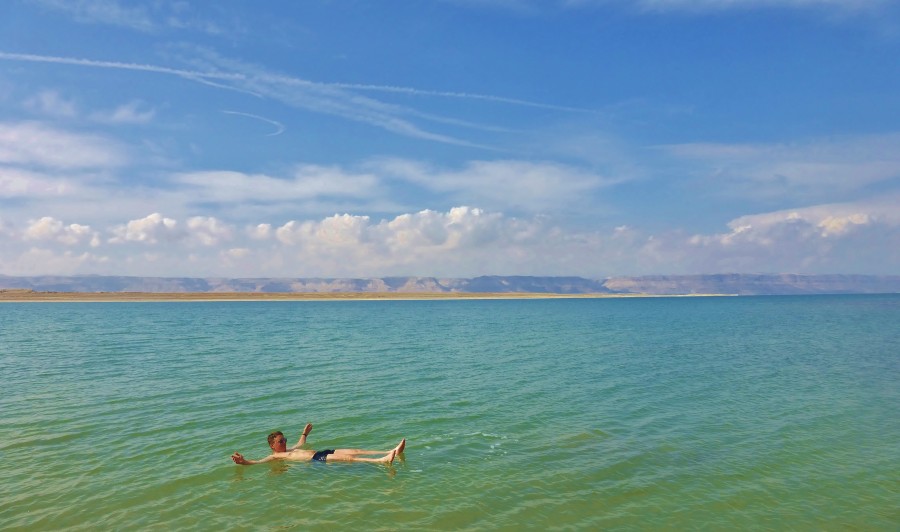
I floated like a rubber duck on the Dead Sea in Jordan. Occupied Palestine on the other side of the shore.
Before I dressed, I first rinsed with water from the bottle, but there was not much of it, so covered with salt I went to the road and the first hitchhike I got to Al Mazra. Then, after a short time I got into a small bus and for only 1JD, beating the picturesque hills, I returned to Karak. I felt satisfied and satisfied when once again I saw the castle on the horizon. (By the way, I recommend a cheap Arabic pub on the hill, where the bus stop Karak – Mazra is located.) I quickly returned to the Cairwan hotel, took a cold shower, took my luggage, and was ready for the next action.
Adventure transport from Karak to Dana National Park
When I was ready to leave, I went to the bus station, but unfortunately there was no transport at this time, so once again I was left with only hitchhiking. Also from Karak, I took a hitchhike to Mu’tah , a small Jordanian transport village, where people rushed into buses in a hurry. The women were sitting separately at the end, while a few young, tiring Arabs sat next to me, who did not speak English well but had a lot of questions for me. In this way, for the magical sum of 1JD and in 1.5 hours I arrived to the village of Tafila , which turned out to be a dirty, uninteresting hole with one street full of shops. I did not regret leaving this city and I was glad that I had a bus right away. With Tafila I went to Al Qadisiyah , for 1JD. This section of the ride lasted 1h, but 2km in front of the village, the driver suggested to me that he would drive me to the Dana National Park for an additional 2JD. It was already dark, and from the road to Dana Tower Hotel, where I had a reservation, it was still about 4km. For this reason, a reasonable decision was to pay 2JD.
My journey has come to an end, although I would like to point out that I have accurately described all my stops to show what the transport in Jordan looks like. Although the country is small and the distance that I overcame could be overcome faster, unfortunately there is a lot of changes, and the buses leave only when they are full. All these things slow down the transport, but on the other hand, I think that the experience is good for travelers.
Dana National Park
I arrived in Dana National Park late in the evening after dark. My hotel was in the center of the ancient village of Dana, which I liked very much because it suited the surroundings. The hotel was built of stone, and although it lacked stars, it was the best for me. I had the impression that the hotel was part of a canyon because all the materials used for its construction came from the surrounding mountains, hot water in the tap was heated in the day by the sun, and instead of heating I had a warm quilt with geese feathers that grazed in the area. In the room I had rugs on the wall decorated with local patterns, and at dinner the food was healthy and natural. The milk came from goats, which I saw on the way to the canyon, and while drinking tea on a stone terrace, I had a view of the mountains. This pleasure cost me 12JD with meals.
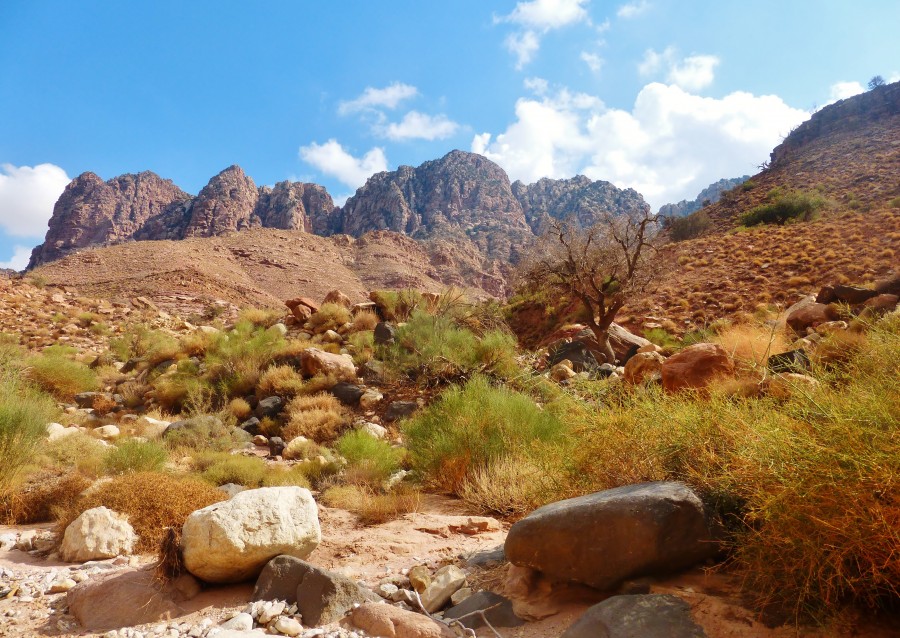
Jordan; Dana National Park.
The Dana Nature Reserve is the largest national park in Jordan, near the villages of Dana and Wadi Dana, and occupies an area of 308 km². The Dan Biosphere Reserve is located at an altitude of 1500m above sea level on the Qadisiyah Plateau, near the low-lying area of the Waadi Arab Desert. Dan’s reserve is also very diverse geologically because it has sandstone, granite and limestone, and the only nature reserve in Jordan, which crosses 4 biogeographic zones: Mediterranean, Saharan – Arabian, Sudan and Iranian – Turanian. There are 703 species of plants, 215 species of birds and 35 species of mammals in Dana, but unfortunately they lead a secret lifestyle. The most interesting species include: Mediterranean cypress, Nubian capricorn, and kestrel (belonging to the hawk family).
Although tourists go to the Dana reserve mainly because of the natural beauty, in my opinion it is also a very interesting place in terms of culture, because it is inhabited by the people of Al Atata, who are connected with this region for up to 400 years. Nevertheless, it should be noted that, according to archaeological discoveries, the first human settlement in the Dana region was founded 6000 years ago. I also think that the ancient village of Dana and its surroundings are also a very good place to observe rural life. After the trip, I went upstairs for about 0.5h, so that I could have a good view of the ancient village and take pictures. I had a good contact with people there, met young boys grazing animals and stroked the donkey, which made me happy like a child. Once again, I realized thatthat I love nature and I have a great need to commune with animals, over contact with people.
The next day, early in the morning, after a modest breakfast, I went to the Wadi Dan trail. The whole trail, to Feinan Lodge, is 14 km long, but I went 8 km into the canyon (an hour behind a narrow, red stone), and then I came back. Somebody could laugh at me, that I went only 8km, but it would be only one who does not realize the shape of the Dan Reserve area. First, I had to go down sharply, and then go through the boulders, admire the picturesque landscapes, pass through the mountains and through the big red stones, as if someone painted them. Several times I had to climb the vertical walls, squeeze through the cracks in the rocks, and I also had to jump from about 4-5 meters, and so as to hit the safe ground.I also talked a few times with goats’ shepherds and I took pictures of rams with the largest and most winding horns. Dana’s reserve was certainly not boring because landscapes changed very quickly in short intervals, and the boulders on the road were always different. In general, it was a beautiful one-day walking tour, which was not easy, but I advise to leave early in the morning and see as much as daylight daily. This is very important information that should be taken seriously when planning a trip.but I advise you to leave early in the morning and see as much as daylight daily. This is very important information that should be taken seriously when planning a trip.but I advise you to leave early in the morning and see as much as daylight daily. This is very important information that should be taken seriously when planning a trip.
I always organize my own trips, but I will add that you can go with the group for an exorbitant price of 70JD, including a car that accommodates a maximum of 5 people. In this case, you should descend 14km down the gorge at a certain time, and at the end of the route, at Feinan Lodge, take the car, which returns to the ancient village of Dana outside the mountains up to 120km. In my opinion, it does not make sense because the mountain expedition takes only 14km and driving a car on an uninteresting road until 120, and often after dark. In addition, you should know what routes you can take, because some are easy and free, while others cost because they require a guide. I of course recommend myself, and I think that by sticking to the main road, or doing small escapades, remembering the starting point, we will certainly not get lost. I advise you to leave since dawn with water and a few fruits.
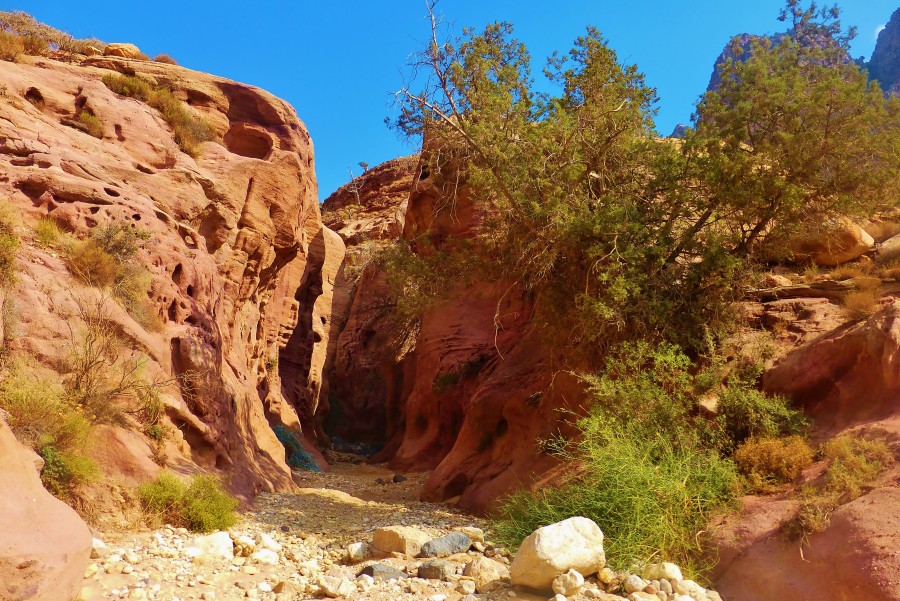
Jordan; Dana National Park.
I think that you should definitely stay in Dana for a few days, especially that it is on the way to the popular Petra.
Transport from Dana to Shobak Castle
The next day, after tea, two Italians took me 2km to the main road, where I hid my backpack between the rocks and admired the mountain landscape from above the cliff. I had a good view of the ancient village of Dan and the grazing sheep, and I found animal bones. It was my farewell to Dan Park.
Soon I took my backpack and went to the village of Al – Qadisiyah , which is a dirty and boring hole, where the local mullah from megaphones on the minaret effected Muslim propaganda, and where an Arab boy shouted “money” at the sight of a white man. The town was tragic. The children asked for money, the elders watched me like television, the hungry cats poked around in the trash, and the Muslim prayers sounded like calls for war. As soon as I left the village, I managed to catch 2JD hitchhiking, which took me to my next destination – to Shobak Castle. I got farther away from the castle to take better pictures, and then I came to an asphalt road, from where a local old man drove me upstairs to the gate.
Shobak Castle
Shobak Castle is located on a hill, in the wild nature, and in a remote area. This castle was built by the Crusaders in the 12th century, specifically by King Baldwin I in 1115. The castle long repelled Muslim invasions, but when the nearby Karak was conquered, the smaller Shobak castle also fell. Christian soldiers, however, were very valiant, because they were defeated by the armies of Saladin only after the 18-month siege. In the 14th century, Shobak Castle was under the control of Mamluks, and then passed into the hands of successive Muslim armies, including the Ottoman Empire.
Today, the Shobak castle is certainly less complete than the Karak castle, but its location, great views and many ruins located in its area give a sense of time. Inside, there are stone ruins that have been transformed by subsequent owners. For example, the Crusaders built churches, which Muslims later transformed into madrasas (Muslim schools), and earned stone verses from the Koran on its walls. In spite of this, many remains of Christianity have been preserved in Shobak, and one of them is a cross pierced within the walls, although there is also an observation tower built by the Mamluks near it, and plaques with inscriptions of two religions. In the castle there is also the main square, a place for baptisms and a secret passage leading down the valley, along the treacherous, dark stairs.I also advise you to pay attention to the reconstructed stone arches in the ruins of the church. Do not expect equal roads and entire buildings in Shobak Castle. I stress; it is a ruin.
Once again, I recommend beautiful views from the castle on the rocks and the picturesque emptiness and silence. In addition, I advise you to walk about 2km through the castle and put some effort into crossing the uneven terrain, through the desert and sharp bushes. Along with moving towards the castle, our hardships will be compensated by better and better views, and I think that in this way we will better remember the Shobak castle. I also liked the massive main gate and stands with carpets, materials, and interesting stones and horns of animals. Those who are lucky will take pictures of Arabs dressed as soldiers of Saladin.
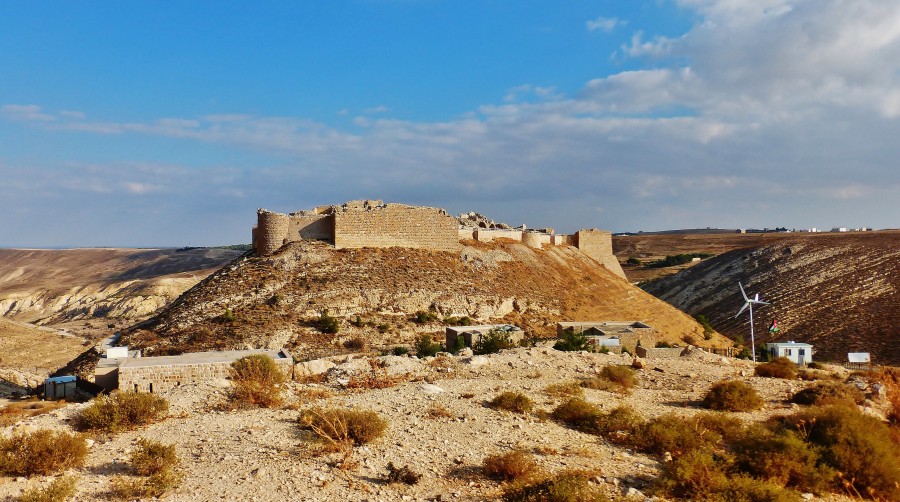
Jordan; Shobak castle.
I also warn tourists not to hurry to Petra, because Petra certainly will not escape, and the castle Karak, and then the castle Shobak are on the way.
My very interesting journey from Shobak Castle to Wadi Musa (Petra)
After seeing Shobak’s castle I went down to the Ministry of Tourism building, where I drank tea with a mint and browsed the souvenirs. I sat in the shade, under the cover of material and looked at Shobak’s castle. I felt so good that I was an hour, but I realized that I had to go ahead. When I got to the main road, someone picked me up to the town of Shobak, which is about 7 km from the castle. Shobak is another boring town, which was on the map because it is near the castle Shobak, and lies 35km of Petra. When I was walking through the town, people went outside to look at me and pointed to Petra. It was obvious to them that the only white in the city must go there.
This time the hitchhiking was not only free, because the driver gave me 15km to my home, and then we sat on his doormat in front of the house, and offered me bread, chicken and salad. During the meal, my Arab benefactor told me what kind of Muslims are good, how they love all people regardless of religion, and how much wisdom is in the Koran. I instead told him Christianity, because as I said: “Christians are very good people who love everyone regardless of religion, and besides, in the Bible there is a lot of wisdom that I recommend”. After a minute of silence, we changed the subject, thanked him for the ride and for the meal, and I honestly shook my hand goodbye. Then I walked along the road, carrying my big backpack, and the Arabs slowed and shouted, “Petra?”.A few wanted to give me a lift for 10JD, but finally the Jordanian stopped working in tourism and spoke good English, and drank vodka while driving, so just in case, I kept the steering wheel for him to get there. After about 0.5h of driving we got to Wadi Musa, which is a well-prepared tourist base to Petra.
Wadi Musa
Wadi Musa is a tourist ghetto, just a few kilometers from Petra. I stayed at the Qasr Al-Bint Hotel for only 5JD per night. I was very pleased, because although it was a single room, I lived alone in it. I also had free tea and a hot shower because the sun heated the water in the tanks throughout the day. The only problem that did not let me to sleep was a mentally ill rooster who started his concert from 4 am and never stopped, and his favorite place was my window. Once I threw a shoe at him but it did not help, because he came back and tossed his beak even louder. In the hotel I also met a traveler from Poland, with whom we thought how to save 50 euros on the ticket to Petra and get there for free. As it turned out later, it promised us another, interesting adventure.
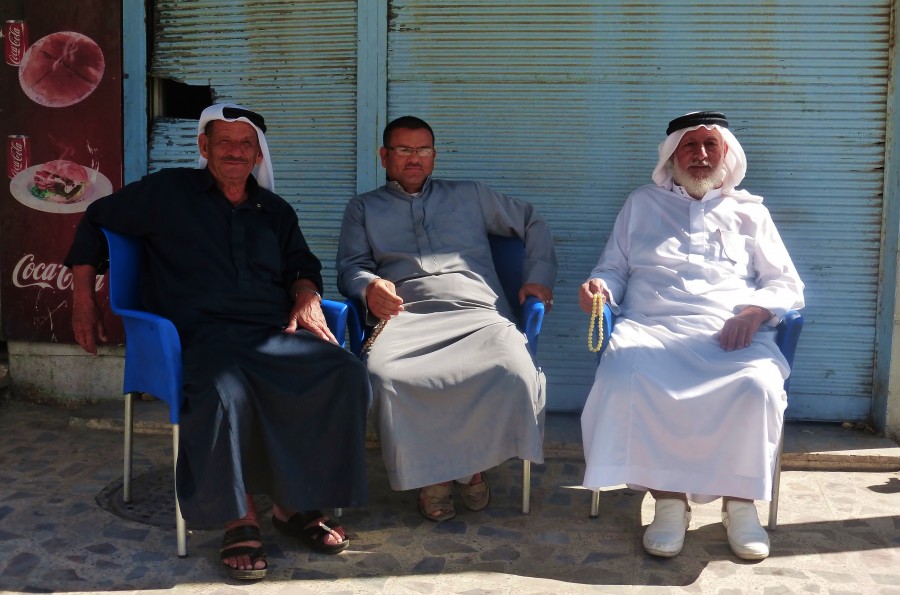
Jordan; men from Wadi Musa, close to Petra.
The receptionist was exceptional too. He looked like he had not slept in a few days, but he was awake enough to remember that the price for a room depends on how the traveler can bargain. (In Vietnam, for example, it was the same: everyone in Halong Bay in the same boat and everyone paid differently). In Wadi Musa Germany paid 40 euros, although they wanted 50 euros, the French paid 25 euros, and the Poles only 5 euros, because the Arabs knew that the Poles would not squeeze more. That’s why they first asked me where I was from, which is also a tradition in Tajikistan , for example). The receptionist was nice when we reached the market but lonely white women should be on their guard. I remember the situation when he gave me a computer and said: “Martin, you only sit there, use the computer and do not interfere,” and then gave the white tourist beads as a gift, and when she thanked her, he grabbed her neck and kissed her mouth so hard that until she made big eyes in surprise. Then she looked at him in great astonishment, turned on her heels and returned to the room. After that it was all right, no Arabs were chasing her, but this is another proof that White women should only ride in the company of a husband or father.
In addition, in Wadi Musa I was in a few restaurants on mutton skewers with onions, I was in the laundry and also in the bakhlava shop. Every evening I went to a pub for tea with a mint leaf, talked to local Arabs and was glad to be in Jordan. I believe that Wadi Musa is a very nicely organized, small town, the advantage of which is, of course, the vicinity of Petra, but also a relaxed atmosphere and desert views. The whole town offers many souvenirs from Petra, there are plenty of hotels for the poor like me and for the rich on organized tours. In Wadi Musa, every Arab with a donkey is a potential guide. You can’t get lost there.
Road to Petra, through the secret canyon
I got up at 6 in the morning and with my Polish friend we went to visit Petra. The problem was, however, that the Arabs only paid 1 JD for entry, while our representatives had 50 JD for 1 day, 55 JD for 2 days and 60 JD for 3dnia. These prices were in force in 2015 when I visited Petra, and the price was so exaggerated that even the Jordanian Ministry of Tourism agreed to reduce the entry for the Whites to 21JD for 1 day, but only from 2016. So we came up with the idea that there is no point in overpaying, if you can try to enter for free and experience an interesting adventure. So we went to Petra around, through a narrow canyon, which turned out to be a unique adventure. We walked in two through isolated areas, we had to be careful not to fall off the rocks, and sometimes we squeezed through very narrow gaps. Once I also had to jump from a 3m high rock to the distance, because I had water under me. I bounced as hard as I could, but I did not have a good run-up, so I fell into my water all the way to my knees. (I have a recording from this jump.) But the climate was very dry and hot, so in Jordan it is not a long-term problem.
We had maps and a plan with pictures of plants and rocks from illegally getting to Petra through the canyon, because before us someone had already done it before. From time to time, someone risks, and I drew my inspiration from SneakIntoPetra.com, which is no more. Despite the maps and photos, in a tiring, hot climate, we were afraid that we could get lost, although the topography of the area was in line with what I saw inside the canyon. When we left the red rock fissures, we came to a more open space, and then to the rock tunnel. In that place we had to behave very carefully because before us we saw the patrols of the tourist police, and then the booth, where the police waited with weapons and binoculars. I realized that since I knew about the secret free passage to Petra, the Arabs brought up in the desert all the more. So I had to act quickly and decisively, so when I saw that the police turned around, I ran off the rocks unnoticed and joined quickly the group of paying tourists, which I then left. At that moment I knew that I won, because the ticket offices and main controls were about 1km behind me, and I was sitting on the rocks and calmly looking at the police, and they at me. Then I drank water and talked to the police so that my travel companion could slip free too. I thought: “What an adventure, I was in Petra, but as if I was not there.”
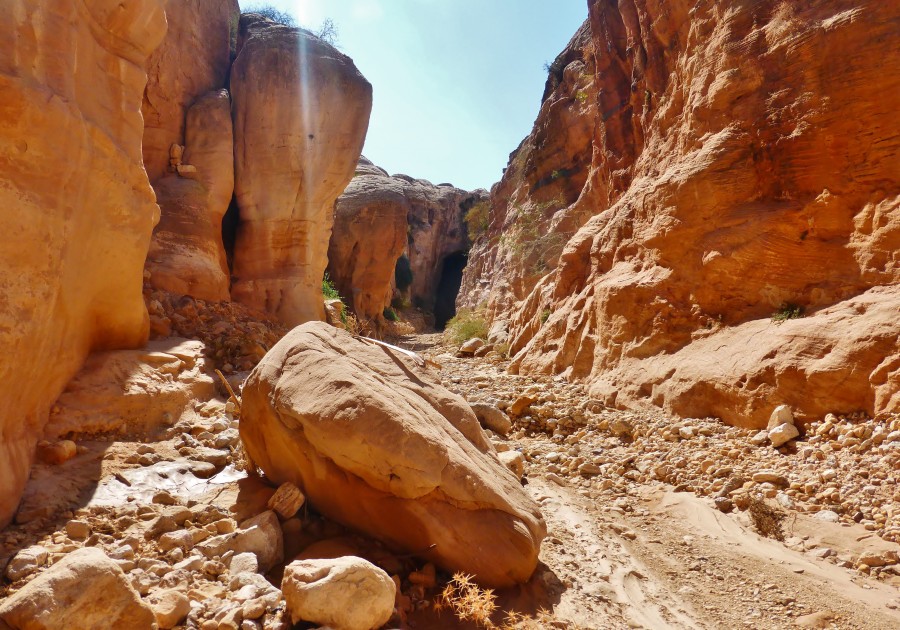
Jordan; the secret red canyon leading to Petra, thanks to which I got into Petra for free.
The next day I also wanted to go to Petra, but I knew that I would have to show a ticket for 55 euros, and on the other hand I did not want to defeat the canyon and jump into the water again. After the first day I was very tired, so I felt that I worked off my 55 euros. On the second day, I planned to enter for free, but this time I wanted to enter without effort, and I realized that in order to achieve my goal I had to be even more brazen than before. My second day I went to Petra on the way for normal tourists and when they asked me for a ticket, I started looking for him and I was pretending to be very surprised that I did not have him. When they started to direct me to the exit, I said I can prove that I was here yesterday because I have pictures. At that time, the guards and policemen looked at the pictures, but their argument was that I could have done them two years ago. Fortunately, I predicted this question, and that’s why I set the camera in such a way that yesterday’s date would appear next to each one. They commented: “yeah, you do not lie, you were here yesterday.” You can not hide, I was, but I did not want to develop this story. In this way, my second, free day in Petra began.
I would add that during my travel career I was already an illegal immigrant, and in countries where people usually run away. When I was in India, I crossed secretly to Bhutan, from where they deported me, but then I proposed that I give my immigration guards my passport if I let them in for half an hour to look around.However, I stayed an hour and therefore deported me for the second time. I explained that I am not a military or economic refugee, but an adventurer. I just wanted to pitch a tent for their part of the Himalayas and live in the wild. Nevertheless, they handed me my passport and pushed it back to India.
I believe that until today I am also the only illegal immigrant in the world to Afghanistan. When I traveled around Tajikistan, I crossed the river Piandz to the other bank, and walked around Afghanistan for about half an hour, and then again returned to Tajikistan.
Petra – general information
Before I go to the description of places and my impressions from Petra, I think that first I should say what Petra is. However, it will not be a lecture on the history of culture and art, but only introducing travelers to the subject of Petra, and my desire to be interested in this unique place. Petra (in Arabic البتراء, Al-Batrā) is an ancient city in southern Jordan with an enormous historical and archaeological value. Petra is located in a canyon in the desert, between mountains, on the slope of Al-Madbah, near the Arabah Valley, stretching from the Dead Sea to the Gulf of Aqaba. According to archaeologists, the territories of today’s Petra already had their inhabitants around 9000 BC and it was probably founded in the fourth century BC as the capital of the Nabatean kingdom. The Nabataeans were constantly moving Arabic tribes originally originating from the Arabian Peninsula. This ancient tribe defeating the Arabian sands in camel caravans mainly traded in spices and survived from trade and animal husbandry. When they got to southern Jordan and found strategically located canyons and defensive mountains in the area of today’s Petra, they decided to establish a capital here. An additional advantage was also close proximity to trade routes, which together with the development of Petra became the main commercial center in the region.
It can be said that Petra’s good times lasted about five centuries. In the first century BC, the entire Nabatean Kingdom underwent the Roman Empire, but its total independence lost in 106. The Romans developed trade and expanded Petra (in their own way), which, despite the dependence on Rome, pleased the Nabatans, but on the other hand it was the beginning of their end, because after the emergence of permanent trade routes operating in favor of Rome, Petra lost its importance. Then, in 363, there was an earthquake that destroyed many objects, and further attempts to rebuild Petra were already lost in advance. In Byzantine times several churches were built there, and after the conquest of Muslims, Petra became a city with no future, and apart from a few Arabian nomads, no one lived there anymore. As a result, in the second half of the fourth century, Petra became a forgotten place in the desert, and it was forgotten not only by Europeans but also by Arabs.
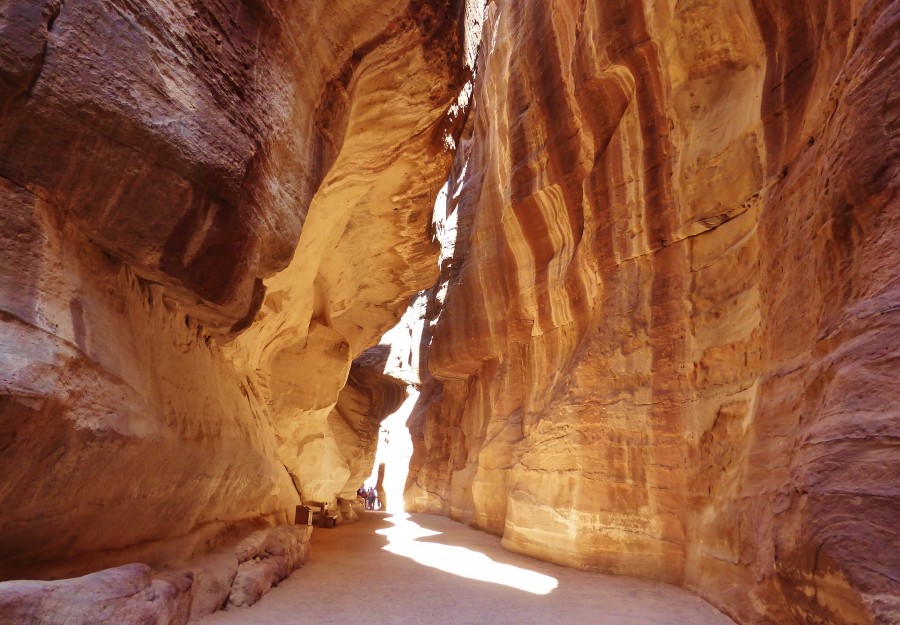
Jordan; Petra – Siq Gorge.
Petra was rediscovered for the watch in 1812 by a Swiss explorer and explorer named Johann Ludwig Burckhardt . This magnificent, amazing place, famous for its rock architecture and water canyons, was included in the UNESCO World Cultural Heritage List in 1985, and was named “one of the most valuable cultural properties of human cultural heritage”. Petra was also included in the 7 New Wonders of the World and became the symbol of Jordan, which in 2010 was visited by 1 million tourists.
Next to Angkor Wat in Cambodia, the Great Wall in China or Machu Pichu in Peru, the so-called Treasury of Pharaoh (in Arabic الخزنة, Al-Hazna) joined this honorable list. The amazing thing is that the Arabs had Petra under their noses for centuries, but they did not realize its value, and only a fearless White explorer and explorer gave the world the opportunity to feel what he discovered over 200 years ago. By the way, it was similar to Angkor Wat in Cambodia , because there the Asians also had an ancient city in the jungle under their breath, and they also did not realize its value; until the brave French naturalist and traveler Henri Mouhot discovered this ancient city in 1860. (This paragraph is dedicated especially to the tireless promoters of “white guilt”).
Petra – my two days
From what I have noticed, Petra is known to the Europeans mainly from the movie “Indiana Jones and the Last Crusade”, where the main character gets on a horse in front of the Pharaoh Treasure Chest in the rocks and departs with music in the background. However, the Archaeological Park of Petra is not one object, but an ancient city, which covers an area of 264 square kilometers. In its area there are red canyons, temples carved in rocks on the surface of the earth and in the mountains; there is also a theater, a Roman street, water channels forged in rocks, living rooms carved in the mountains and even an altar intended for ritual sacrifices. Petra is a city of natural beauty and rock art, which is over 1500 years old, and which requires efforts and learning from travelers.
Petra can be visited in several ways. I like to reach out everywhere and devote more time to visiting places and interacting with local people. I like to devote to each object the optimal time to understand it better, and to drink tea with Arabs in the desert, and to bargain with them for another silk scarf for my pure Slav women. Sometimes I also talked about politics because the Bedouins were curious about how it is in Europe and they were also honest about their opinion of Europeans who were not good; especially when it comes to our women. In summary, I would like to point out that Petra is a complex of very interesting historical objects that deserve the best time, although people selling souvenirs are also interesting because they allow a better understanding of this place.
Many European and American snobs think that the poor one is stupid, but in my opinion the opinion of a poor Arab brewing tea on a slow fire or offering a ride on a donkey is very important, because without him I would not have fully valuable travel memories. In addition, I advise you to hire a guide, because in this way we will learn more, and our euro and pounds will go to those who need it most. This is my way, but to get some luxury I got on a donkey.
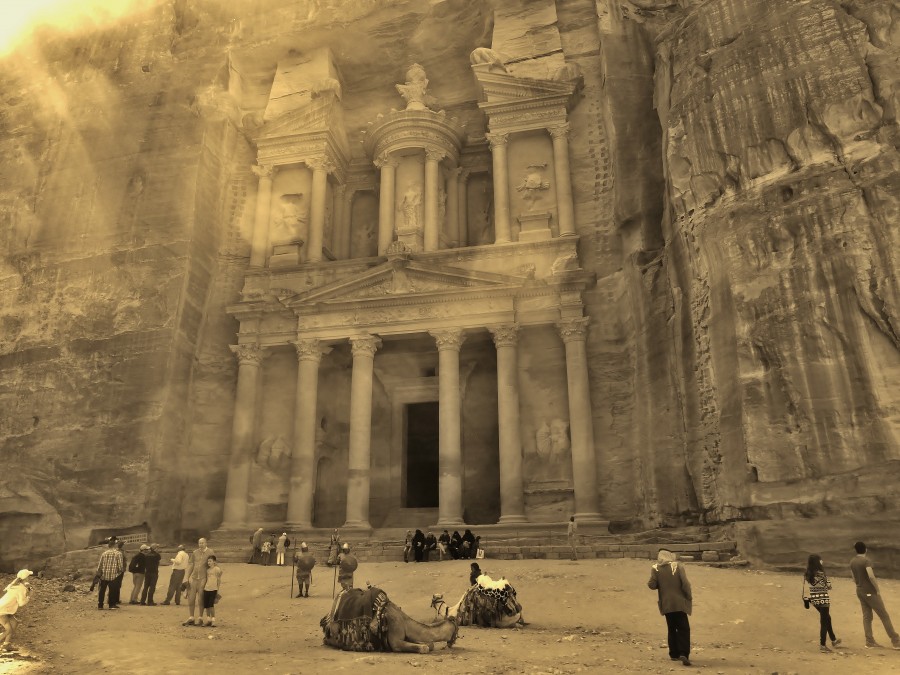
Jordan; Petra – the Treasury.
The second way of exploring Petra is organized trips, where tourists have little contact with people but also little contact with monuments. I saw such a trip in Petra, and unfortunately it was limited in time, because tourists were constantly pursued by a guide like a herd of cows. I advise against this way. I also saw tourists in Petra completely disconnected from reality, because they traveled with covered horse-drawn carts, without seeing anything that was happening around them. Sometimes, they just stopped at the main monuments so as not to leave the car to take a few pictures. What’s the point? I do not know and I was not able to ask because they did not have time to answer. Therefore, I would like my readers to answer the question which way of visiting Petra is the best.
The most interesting objects in the ancient city of Petra:
Visiting Petra started from the east side, from 1.2km walk through the Siq Gorge, which leads directly to the Treasury of Pharaoh. The Siq gorge is a picturesque passage between red sandstone rocks, with dramatic shapes, different widths and with magnificent rock formations. The first thing that occurred to me was, of course, the vision of the gorge being shaped by a huge river, or so-called water erosion, but the Siq gorge was created by tectonic forces that caused the sandstone mountain to split into a deep, narrow path. My critics who consider themselves to be geopolitical experts may ask why the rocks and all the edges are smooth, to which I would reply that the Siq gorge was made by cracking rocks, but was then polished by water. This spectacular red gorge is usually 3m wide, although sometimes it is wider, and sometimes it is so narrow that a beautiful naked woman sunbathing in this place could touch both sides of the rock with your fingers and toes. In the Siq gorge you should also pay attention to the bas-reliefs, underground chambers and channels carved into the rocks, which were intended to bring precious water to all parts of the ancient Petra.
At the end of the ravine the road began to be very narrow, and before me appeared The Treasury (لخزنة, Al-Khazneh) , or the symbol of Petra and the symbol of Jordan. I found myself on a sandy square surrounded by mountains, where the Arabs stood with camels and donkeys, and where there were shops under tents and posters with the King of Jordan. Of course, the most important in this place is the Treasury, but I was not in a hurry. First, I walked around the square, I stroked camels and donkeys, I bought water and then I exchanged a few words with a beautiful Ukrainian woman who was traveling with her husband. Well, there was nothing else to do but devote attention to the main object. Al-Khazneh is the most famous and most decorated building of the ancient Petra, which was built of red sandstone in the first century, in the times of the Nabatean ruler named Aretas IV Filopatris. This building was in fact not a treasury but a mausoleum and the crypt of Aretas IV, although the legend says that in the stone urn inside the building, on the second level, ancient wealth was hidden. This is where the name “Skarbiec” comes from, as the Bedouin government knew about the quick money, who in the 20th century shot the urn with bullets, believing that gold coins would fall out of it. Decorated with urn patterns, however, it is only a hard rock, but bullet holes have been there to this day. Another legend says that Al-Khazneh was the treasury of Pharaoh in the days of Moses, but whatever the imagination, it is a grave crypt of solid sandstone, with a very impressive facade carved in the rock. On the wall there are also many bas-reliefs symbolizing life after rubbish, and thus, for example, we can see eagles there, whose task was to transfer the souls of the deceased to the other world. In addition to them, columns are also carved in the rocks and a spectacular roofing.
Al-Khazneh is known mainly from the third film about the archaeologist and traveler Indiana Jones, but this special, unique object is so widely recognized throughout the world that he also appeared in the music video of the band “The Sisters of Mercy – Dominion”, the film Transformers ( 2009), and many other films and series. Petra, and especially the Treasury with camels posing for photos is a wealth of world culture.For this reason, I warn you to respect him and not rub against his rocks, do not lean against him and do not wipe his hands. Because of the tourists’ backing against the pillars and walls of Al-Khanzeh, its walls have narrowed by 4cm in 10 years, and resting the hands also causes the formation of stearic acid, which explains why white spots appeared on the site. In addition, Petra is in a dry, hot climate and sandstone is sensitive to moisture, which means that a million tourists annually who breathe in this place certainly does not help. Let’s take care of this object for future generations.
I will add that the Treasury can also be viewed from the rock above, but how to get there afterwards. It is also very popular to watch the Treasury at night by the candlelight.
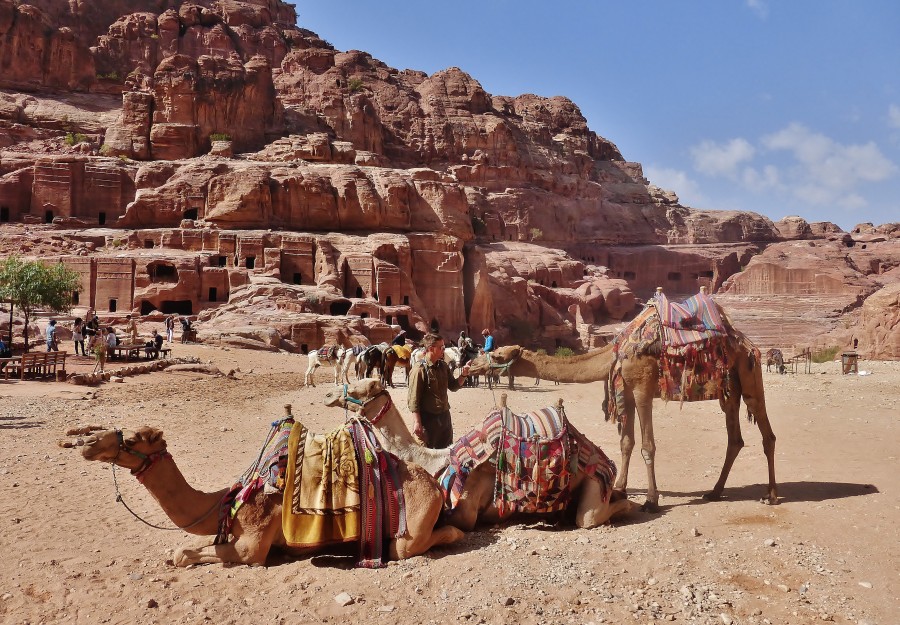
Jordan; Petra – with camels.
When I left the square where Al-Khazneh was located, I went through another gorge, usually referred to as Outer Siq , until I came to a large open space called Fasade Street. It is a huge, wide area, where there are about 40 tombs and mausoleums in many sizes and at different heights, but architecturally referring to the Treasury. I spent time there walking on rocky roads higher above the ground, and reached rooms with many shapes and patterns on the walls. At first I thought that these were residential homes carved in the mountains, as in Hasankeyf in eastern Turkey, or in Goris in Armenia or in Kandovan in Iran, but in Petra, the facades were not houses, but tombs, and those that were the smallest. they were intended for the poorest.My guess is that in the culture of the Nabateans, death and preparation for death itself could have been as important as in ancient Egypt. In some tombs there was only mud and dust, while others had equal, naturally multi-colored walls. It was also amazing that without the use of advanced tools, already thousands of years ago, the Nabataeans were able to hew even walls in the mountains.
Many tourists are rushing through the facade streets, but in my opinion it is a mistake, because here you can see Arabs on camels and donkeys, and Bedouins selling souvenirs and cooking tea on the bonfires. In addition, the exploration of tombs is easy and gives pleasure to people who love to explore. Many tourists bypass the Facade Streets also because there is a little further away the Theater hewn in hard rocks. Its shape resembles Roman theater, but one should not be fooled, because the Theater was built by the Nabataeans about 2,000 years ago. It was built to accommodate 3000 spectators in 45 rows. However, when the Romans entered Petra in 106, they immediately enlarged it to accommodate 8,500 spectators, or about 30% of Petra’s ancient population. So the theater was of great importance in the Nabatean culture, since they took the trouble to undo the iron-hard rock and to implement such an ambitious project. At the back of the Theater there are more tombs carved in the rocks.
Another object carved in the rocks are the Royal Tombs , which look like a palace on a wall of red sandstone. Of the many, one should certainly mention the Urn Tomb , which is built higher up on the mountain wall, and according to archaeologists, it is the tomb of the Nabatean king Malchus II, who died in the year 70. The tomb also has magnificent columns, three burial chambers and arches carved in the rocks when it was transformed into a church. Next to it is the beautifully colored Tomb of Jedwabne , and then more damaged but reminiscent of the treasury of Al-Kahzneh, the Corinthian Tomb.
The Palace Tomb was very impressive, whose front wall with 18 columns is reminiscent of a palace, there is also a large chamber inside, and outside there is a courtyard, most probably intended for funeral ceremonies. From this place, an antique city can be clearly seen, because it is located a few meters above the ground. I believe that the tombs were also of great religious and cultural importance for the Nabataeans, because they were given great importance to their construction. A bit further is the Tomb of Sextius Florentius , who was the Roman governor of Arabia. Inside there are 5 graves, and outside you can drink tea from the Bedouins.
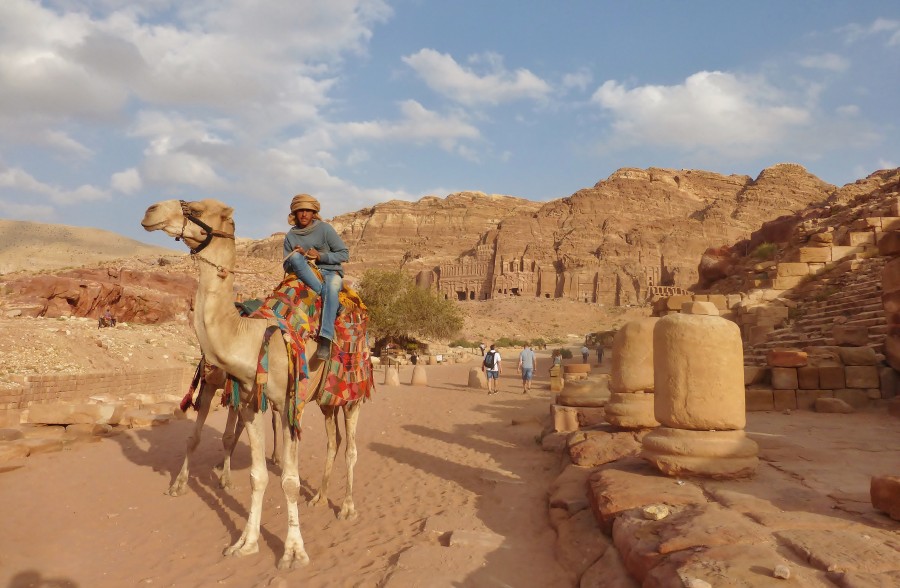
Jordan; Petra – the Column Street.
Then, in the very center of ancient Petra, there is Column Street , also called the Roman Street , called by the local Bedouins. The street was built by the Nabataeans, but as soon as the Romans took over Petra in 106, they immediately rebuilt the Column Street to Roman standards. (By the way, exactly the same at the same time, the Romans built a Column Street in Jerash). Kolumnowa Street in the ancient city of Petra was used until the 6th century as a commercial center, and although it is now ruined and apart from a stone road and several columns, nothing has remained, centuries ago there were 1 and 2 storey buildings that served as shops. Column street starts with the Nymphaeum fountain, built in the second century.
Further, among the stone rows there is a shadowy 450-year-old pistachio tree , followed by the ruins of Faranon’s Ducal Palace (Qasr Al-Bint) . To this day, the stairs and the massive walls of the temple have been preserved, but not the roof. This object was built by the Nabataeans in the year 30 to worship the Nabatean gods, but was later adapted by the Romans as a pagan temple. Given that this palace is already 2,000 years old, I think it has behaved well enough to imagine what it was once. In the years of splendor, it was one of the holiest sites of the Nabateans and was 23 m high. The name itself – the Palace or Temple of the Daughter of Pharaoh is a Bedouin invention, because the temple had nothing to do with Pharaoh but only with the Nabataeans gods. I suspect that the word “pharaoh” appears in Petra several times as a sign of greatness and wealth, competing with ancient Egypt.
Column Street ends with the Passage of Temenos , built in the second century. There used to be a huge wooden door opening the shopping street, but only massive columns remained to this day. Next to it are the ruins of the Nabatean bathhouse , but they did not survive the burden of time. Column Street is always busy and you can always meet Bedouins and tourists traveling on camels. You can make a bargain with them, because if you have a class, you can visit the great area of ancient Petra in a big way, that is, a camel. There are other options, such as horseback riding and climbing to the higher parts of Petra on a donkey. I would recommend!
On the south side of Kolumnowa Street, in front of the hill, there is the Great Temple , discovered in 1921.For approximately 1,900 years, this huge building was covered with Arabian sands, but in 1993, restoration work began. To this day, it is not known whether the “Great Temple” was just a temple or was so huge because it also served as the Nabatean Parliament. This guess may suggest a semi-circular hall, as we know it from the Roman senate. It is also unclear whether the roof was empty in the middle or whether the roofing was covered only by external walls. Inside, you can still see attractive stone arches, sculptures depicting elephants and remains of paintings on the walls, which despite their long years have preserved their expressiveness. In addition, recent archaeological discoveries have provided evidence that there was also a public pool and garden next to the building, not a market square as previously thought. I think that this discovery should be very important to us, because thanks to him we are able to say more about the daily life of the Nabateans. In the years of splendor, the Great Temple was 18 m high, and it was located on a square of 40m x 28m.
In addition to the places I have described, in Petra there are several other interesting objects, chambers in the rocks, bas-reliefs and temples. Petra is a great example of how the ancient civilization has been able to transform naked rocks into the art of building, and thus leave an educational memento for future generations. There is still a lot to be discovered, and that is what I am asking for future travelers.
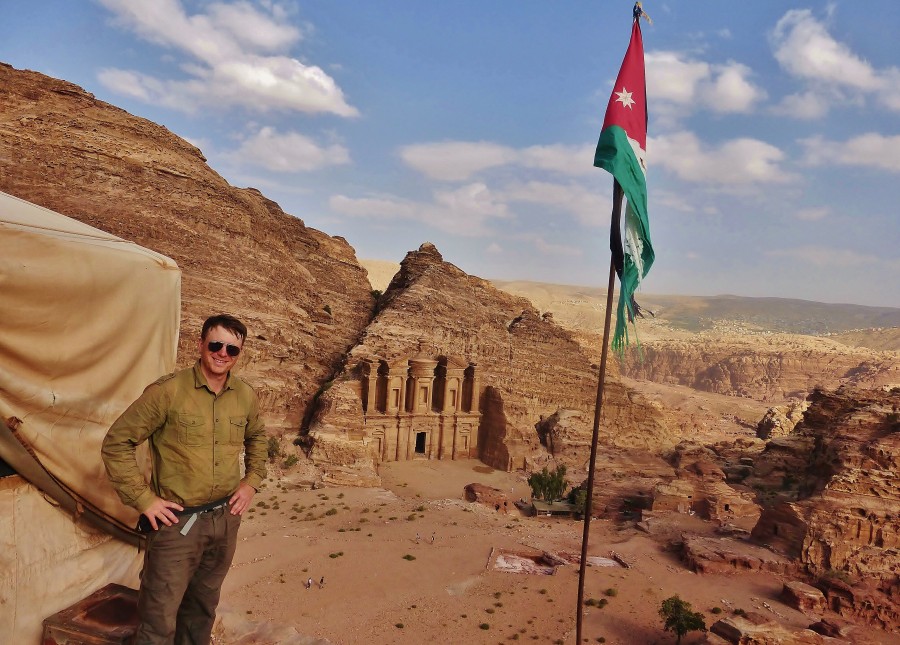
Jordan; Petra – in front of the Al-Deir monastery.
Climbing to attractive places in the ancient city of Petra:
As I mentioned earlier, I spent two days in ancient Petra, and some places were so amazing and offered such picturesque views of the desert and mountains that I had to see them twice. I climbed some places on foot, and on others I would go on a donkey, and spend long hours watching selected objects. The first day was for me to learn about Petra, while on the second day I chose my favorite objects and gave them more time. The second day was also lighter for me because I did not have to cross the difficult canyon. One day is definitely not enough, so you need two or three days to embrace Petra with your mind and remember it well.
Travelers who know Petra just from the perspective of one temple shown in Indiana Jones, do not understand that Petra is primarily a mountain expedition, and therefore to reach some very important and dramatic places, one must put in a lot of effort, which especially in the hot climate of Jordan is even more tiresome. The most ambitious travelers should hire a guide with a donkey or a horse and take water supplies. Less frequently used trails are unmarked and depopulated, that’s why I advise to have an expedition plan taking into account your abilities.
Just behind the Theater there are stairs to the top, leading to the Highest Place of Sacrifice . It is a pleasant, about 30-40 minute climb on the stone stairs, including time to take photos and tea with Bedouins. With proper distribution of forces this climb does not require much effort, but it is better to start early in the morning, because around 12 noon the Jordanian sun is baking without mercy. However, the Highest Place of Sacrifice is not only the place at the top, as the adventure is also climbing itself, red rock formations, tombs carved in rocks and a fountain in the shape of a lion. There are also two statues of Nabatean deities. Marching up the Bedouin trail Jebal El-Kubtha begins with a large stone gate, where you can see the Nabateans stone stairs and corridors, offering dramatic views.
At the top of the Sacred Place of Sacrifice there is a 15m x 6m-engraved altar in the rocks, which in the days of the Nabateans served mainly for the sacrifice of animals to the Nabatean deities. The Nabataeans worshiped, among other things, a deity named Dushara and Al-Uzza, who were also offered human sacrifices in the pre-Muslim Arabia. According to the philosopher Phorpyrius, who lived in the second century, the boy’s throat was cut up once a year. This was also the case in the Nabatean city of Dunat, 300 km from Petra, which is why, given this custom, I think that people were sacrificed to satisfy the government of the blood of primitive gods. The same practice, for example, took place in the kingdom of the Inca and the Maya, and also in the High Place of the Sacrifice, at the top of the temples, under the sky. The Nabatean religion also allowed the corpses of the deceased to be displayed, which was for example practiced by the Zaraostrian Persian. I am writing from all this, because tourists who visit Petra can see rocky landscapes and desert, but Petra was also built on the blood of defenseless people. The religious ceremonies of the Nabateans made shivers.
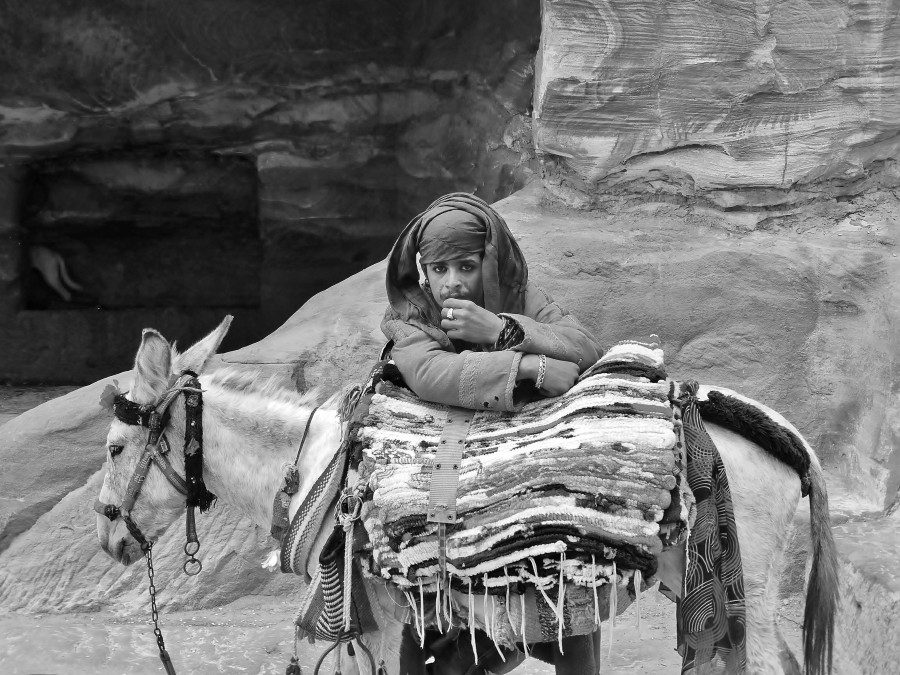
Jordan; Petra – Bedouin with a donkey.
From above, there are, of course, great views of Petra, including the Theater, Kolumna Street and many tombs. On the way back I chose the western route through Wadi Faras. This road is more interesting than the previous one, because I saw some interesting objects. First, I saw a lion-shaped bas-relief with a water hole in its mouth. Then I saw a small cave called the Garden Tomb, with a tree in front of the entrance and in a quiet place. Then there was the Tomb of the Roman Soldier (from the sculpture in front of the door) and next to it also a cave with columns and umbers called the Garden Triclinium. Then I saw the Tomb of the Renaissance, with two columns and a bow carved in the rock. It’s impressive. Then I went back to the Place of Sacrifice and went where I started my climb, but tourists with a guide can see much more and continue to climb to Qasr Al-Bint and even to the Monastery.
Huge pleasure and also many moments of reflection on art and history made me climb to the famous Monastery (Al-Deir) . Stone stairs leading to the Monastery begin near the Nabatean Museum, and climbing the winding road over 800 stairs took me about an hour, because I talked on the way with the Bedouins selling souvenirs, and stopped on the slopes of the mountains to admire the views. The monastery itself turned out to be such a special place for me that the next day I climbed there again, but this time on a donkey. The Al-Deir Monastery was built in the 3rd century BC as a tomb for the Nabatean ruler, probably for Obodas I. The building was built in the same style as the famous Treasury, but Al-Deir is larger because it is 50m wide and 45m high. Besides that the monastery could be built, first the Nabataeans had to retract the mountain by many meters using primitive tools. The door itself is 8m high, and the chamber inside the tomb has dimensions of 11.5 x 10m. Inside there are crosses on the walls, which are proof that this object served as a church in Byzantine times.
On the right side, from the stairs, there is a road uphill, through which you can climb to the top of the tomb, although when I was there in 2015, climbing was already prohibited. On the one hand, this is a way to protect Al-Deir, but on the other hand, this prohibition takes away beautiful experiences, such as details of carved rocks and a picturesque view of the vast gorges and the Wadi Arab. In front of the monastery there is an even square, which in the Nabatean period was used for religious rites, but now it is a vantage point and a meeting place for camel riders offering trips to tourists. There are also very attractive rock formations in front of the square, which provide opportunities for taking photos, and a very expensive restaurant under a tent. When I saw the monastery, I went for a walk up, passing red sandstones of various shapes, and then rested on a cliff overlooking the landscape of Wadi Arab.Sometimes I also saw donkeys, then more tents and also Bedouins that would light the fires. However, I enjoyed the most picturesque views and free sunset over the desert. You can spend hours in the area of the monastery, because apart from the tomb itself, the surroundings are also beautiful.
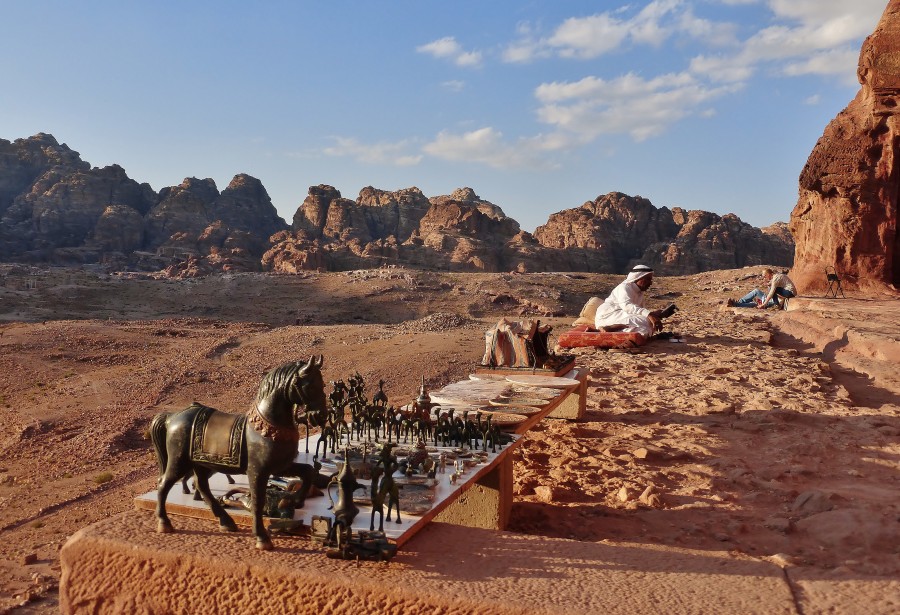
Jordan; Petra – landscape.
More ambitious travelers, as well as having the strength and reserves of water can continue their mountain expedition through the Red Mountains. About 6 km from the Monastery is Little Petra (Siq Al-Barid) , a series of canyons and winding passages between the mountains, where, in addition, there is another, but smaller, tomb hewn in the mountains. Climbing from the monastery should take about 2.5h-3h. I advise you to take the guide with the donkey from the desert level, near the Nabatean museum, and determine that the expedition is to take place at the monastery, and then under 1h-2h stop, go further to Mała Petra and back. Alternatively, you can ask for a guide or for directions in a tent near Al-Deir.
My last trip was climbing to the top above the Treasury. I took this tour late in the evening, that’s why I came back in the dark, but it was very interesting, because on the way I saw interesting rock formations in different red colors, and beautiful stone stairs, not all of them in good condition. At the beginning I would like to say that although for a middle-aged person to get to the top it should not have been a great effort, you can feel exhausted in the Jordanian sun and you can also get lost. On the way, however, there are signs of “best view”, but I warn you not to cut corners and stick to the trail. Climbing to the top takes about 1.5 hours, but some can take up to 2 hours. It took me 45 minutes for it, because it was getting dark. When I reached the top, I saw the Bedouin tent and sat on the cliff to look at the Treasury (Al-Khazneh) from 200 meters on the ground.I consider this climbing as a mandatory point of exploring Petra because the experience associated with this view is really important.
If White travels in a group, I suggest that they give 10JD-20JD to an Arab boy who will happily take Europeans to the top. This way you can learn interesting things, do not get lost, see “little treasures” along the way, such as small tombs in the rocks farther from the trail – and besides, this is a good way for us to help Arab families in their own countries, because the mass immigration of Arabs to Europe will not improve their countries at all, and may destroy our way of life. I support this kind of help, because I believe that different civilizations should help each other, but with mutual respect not only to foreign cultures, but also to their own.
Here are the most interesting and in my opinion obligatory places in Petra, which must be seen and which one should take time to reflect. Petra is a mountain expedition of many rock treasures, meetings with the Bedouins and their interesting way of life. I also think that despite the planned 3 days to explore Petra, travelers who are more ambitious and want to explore this huge area may not be enough. In this case, I advise you to bring tents on the third day and spend the night in an isolated place, and advise you to have money prepared for guides who would undertake a trip to further places. White people often think they are the smartest because they have maps and GPSs, but in this case the Bedouins know more. I say this to realize that you can get lost on distant routes in Petra, and nobody wants to go astray in the desert without water.
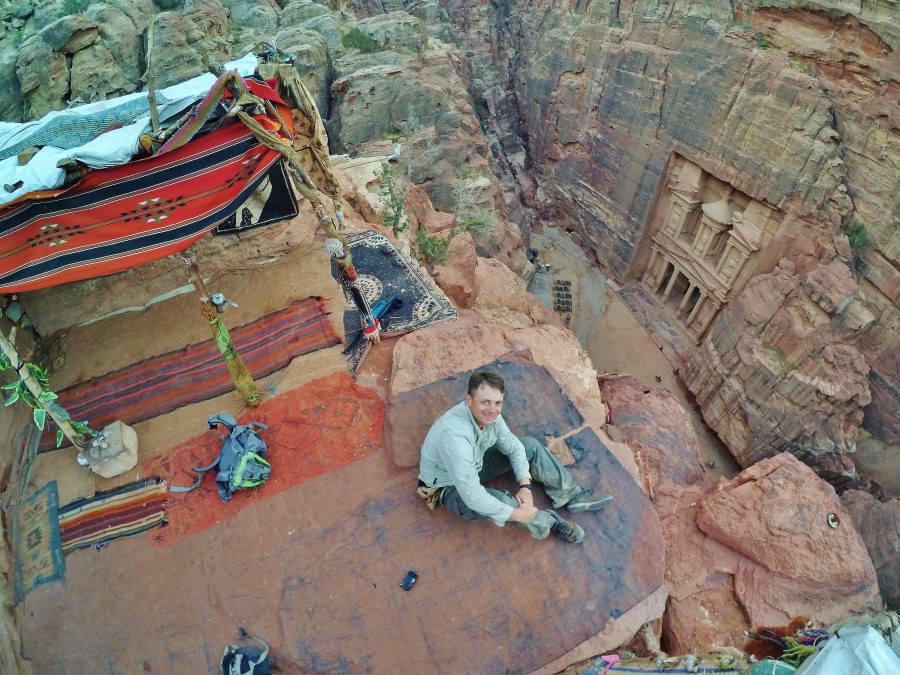
Jordan; Petra – The Treasury seen from the top.
Walking around Petra, travelers will surely come across a heavily advertised book, Fri “Beduin’s wife . “This is a true story written by a European woman from New Zealand, Margeurite van Geldermalsen, who was so delighted Petra that she lost her mind and therefore betrayed her race and her culture, and decided to live in a desert cave and give birth to Arab children. For the Bedouins their culture is extremely important, and not only Islamic culture but also a very specific Bedouin culture, based on attachment to the desert, to living in tents, making tea on the campfire and breeding animals. Bedouin culture is not for sale, the more so that they could go to Europe to make more money there, but they still live in their desert and continue the culture of their ancestors.
In Jordan Bedouins are considered representatives of the purest Arabian blood with a very conservative culture, other than in such cities as Amman or Aqaba. (More about the culture of Jordan, and separately about the Bedouin culture I wrote on the site of Jordan). However, for White woman her culture and her race had no meaning, therefore she decided to deny her values and become someone who will never happen. Pinocchio thought he was a real boy, while the White woman thought she was a Beduin, because she took off her panties in the desert. Bedouins, on the other hand, are clever people who turned white civilization into a great business, often with the satisfaction of degenerate White tourists, for whom betrayal of the race and betrayal of culture seem to be something attractive. I can not blame the Bedouins, however, because I can not hate the man who ate the apple that fell on his head when he stood under the apple tree. Let this paragraph be a warning to the traitors of the white race with a low level of self-worth.
A day of rest at Wadi Musa
The last few days were very tiring for me. In a short time I traveled about 15km in the Dan’s reserve, inside the Canyon, and then walked about 20km through the desert and mountains inside Petra. To all this I was tired of the heat, sand in my eyes and life in hitchhiking. I did not have clean things anymore, and I felt that I needed at least one day to organize, just for myself. So I gave my laundry away, wrote a travel diary, took pictures, ate and slept. Once in a while, such a day is needed and Wadi Musa is great. I had a cheap hotel there and everything I needed, and I knew that now I will not have a chance for such a day. I was heading towards the occupied Palestine, but first I planned to organize an expedition in the Wadi Rum desert, and then I went to Aqaba.Sometimes it’s good to not hurry.
My interesting transport from Wadi Musa to Wadi Rum
The roaming cock and howling dog made me not sleep too deep, but when I got up at 9 o’clock, I packed my big and growing baggage and went to the Wadi Musa bus station. Although Petra is the number 1 attraction in Jordan, transport to and from it is not very good – although it is. I think that this is information in favor of Jordan, because in many countries after which I traveled there was no transport at all. I took a bus to Aqaba for 5JD, who was supposed to leave at 11am, but due to the lack of passengers we had to wait, so we left at 12.15. After about 1.5h I got off the road, at the sign pointing at Wadi Rum, near the village of Al-Rasshidiyyah. When I found myself on the direct route to Wadi Rum, tourists from Belgium brought me to the desert gate.
My arrival in Wadi Rum and the test of strength of characters with the Bedouins
At the gate to Wadi Rum I had a small test of character strength, because the Bedouins wanted to cut me off the cash in a polite way. One of them offered me a tour of Wadi Rum for 200JD, and another for 100JD, while when I was not interested and told them openly that they did not find an idiot, they said that the ticket office was closed and that I could only buy a ticket for 50JD, despite that when they added “the tickets are over.” They wanted to squeeze something out of me, but I had to be smarter, that’s why I looked around, found the money and I bought the ticket for only 5JD myself. When I waved their cheap ticket in front of my eyes and said that they were a bunch of cheaters, one of them suggested that he could give me a ride to the village of Rum for 8JD, but I left a few meters from these tricksters and got hitchhiked for free. I remember when I left them,one of them asked where I was from, to which I replied that from Poland. This allowed the Arabs to understand that it would not be easy with Poles.
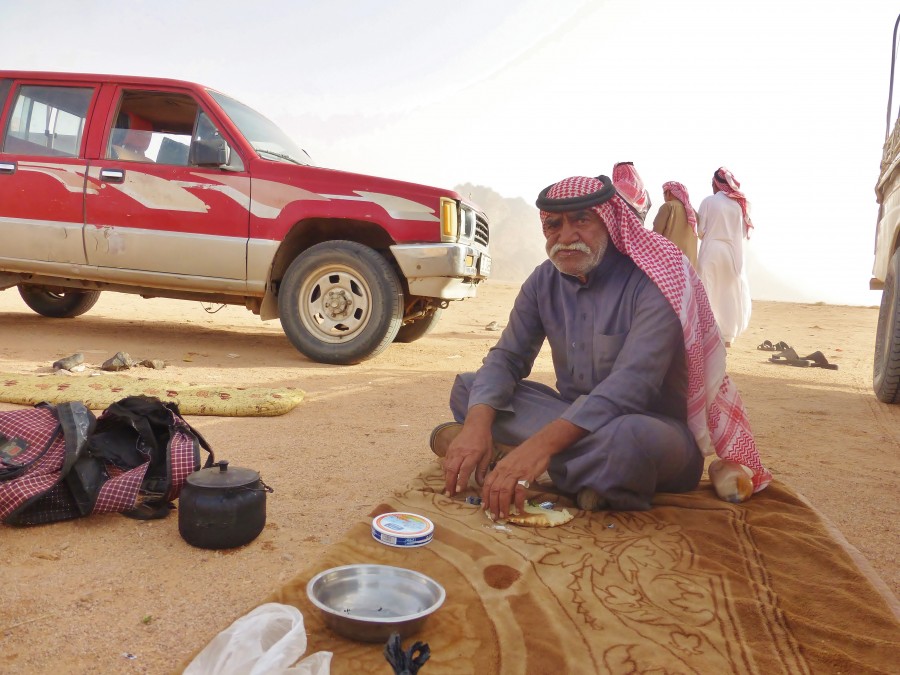
Jordan – I saw this ‘beautiful’ Arab as soon as I got to the Wadi Rum desert.
However, I would like to add that even though interest is sometimes difficult and the economy in Jordan copies Arabs hard on the back, based on my own experience I like Bedouins, because many times they helped me too and in addition, once I had good contact with them. When the business is over, I think that Bedouins are good people who live in a deep respect for their culture. Sometimes, too, I have noticed that the Bedouins are first Bedouins, and then Arabs and Jordanians, and from their statements I concluded that the desert is most important for them, whereas Amman or Aqaba is a different world. Bedouins have a huge attachment to their land.
As soon as I left the scammers first spent a few hours in the desert, where I drank tea with nice Bedouins, and from where I saw a huge rock, named Seven Pillars of Wisdom . It is a huge rock growing out of a flat desert that has five rock pillars as seen from the tourist center at the entrance to Wadi Rum, and another two on the side of the mountain. A view from about 500 meters was enough for me, but those interested can take a trip around and climb to the top. At that moment I was more enchanted by the beauty of the desert, camels with huge rocks in the background, and peace. I drank tea with a gentle breeze and looked at the desert.
After a while, I found myself on the side of the helpful Bedouin car, who was so good that he not only picked me up for free, but also stood by the shop and bought me cookies and water as gifts. However, I was driving not near the driver but in the trunk with goats. Well, maybe he was also a supporter of racial segregation, but he was at home. Then he was so nice, though not exaggerated, that he let me pitch a tent in the desert in front of his fence and gave me access to the toilet. It was not a big help because I could spread the tent anywhere, but at least I had access to the bathroom and something to eat. Beduin’s name was Shaker, and of course he was a business man who counted on buying a trip for 150JD. At the time, however, I did not know that my fate at Wadi Rum would be different. My first night was cold.I slept in a small tent on the cold sand, and in the night howled dogs and camels that stood about 10 meters from where I was sleeping. Yes or no, I survived until morning.
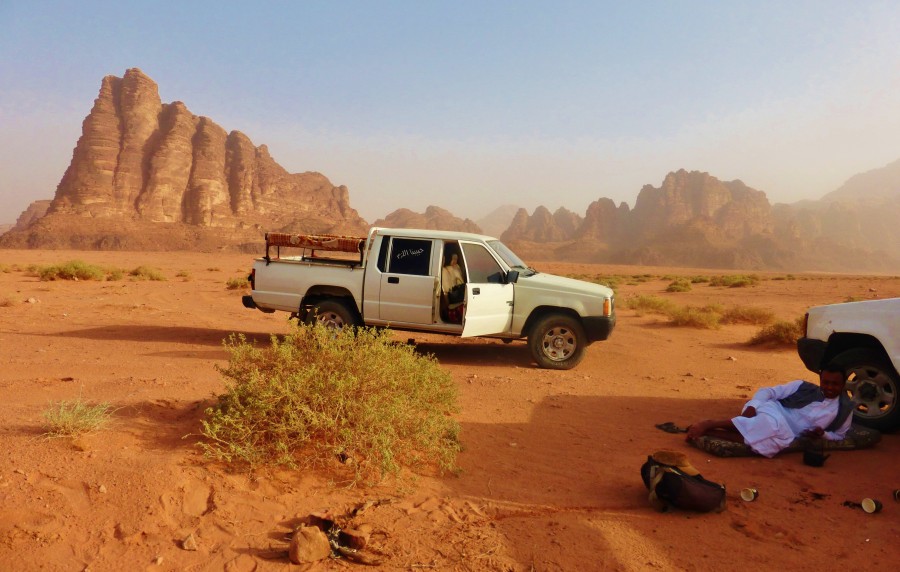
Jordan – Wadi Rum and the Seven Pillars of Wisdom.
By the way, the Rum village is a small settlement in the desert, where there are a few shops, a guest house and a restaurant with a very limited menu. This village is inhabited by a small Bedouin community who prefer to live in a permanent place instead of living a nomadic life, like their ancestors and other Bedouins at present. I think that because of the tourist attraction, which is undoubtedly Wadi Rum, it makes sense.
Shortly about Wadi Rum
Wadi Rum is a vast desert in Southern Jordan, which is a protected area due to its unique natural beauty and prehistoric inscriptions. In Wadi Rum there are many dramatic rock formations, mountains and ravines, and the area is inhabited by Bedouins, mainly living in tourism. Wadi Rum is a hot, picturesque desert where for the needs of tourism this place is identified with Lawrence of Arabia– a British officer who led the Arab revolution against the Ottoman Empire. In his honor there is a source, for example, located near the village of Rum. Although Wadi Rum occupies 720 km², the most important places, such as canyons, ravines, a source, and beautiful rock formations are located close to each other. In my opinion, Wadi Rum is a beautiful place that every traveler should visit at least once in his life. Unfortunately, most tourists visit Wadi Rum on one or two-day trips, but I spent 3 nights there and could have stayed longer. With an adequate supply of water, you can go there in the mountains, spread out the tent at the spring and look for treasures such as skeletons of animals scattered around the desert.
Bedouins, on the other hand, are very well prepared to accept tourists, and although they organize camel tours, they traditionally live in adventure tents in the desert, and cook tea on bonfires – on the other hand, they move by 4×4 Jeeps, do business on cell phones, and have electricity from solar batteries. In other words, they are more modern than me.
A trip with Bedouin to Wadi Rum
The next day I woke up in quite good condition, though I would have slept even if it was not for the heat inside the tent and not for the goat that was rubbing against the tent. I swallowed some water for sobriety, I took what I needed, packed the rest of my robots into a tent and went into the desert. I knew that I could not pay the money to the Bedouins, so I tried to organize an expedition to Wadi Rum on my own. At the time, I did not know that I would be very lucky. When I left the village of Rum with a small backpack and water, I walked 2 km through the desert to the Source of Lawrence, where there were big tents, and where the Bedouins brought tourists to regroup there, depending on the direction of the trip. The source of Lawrence is a well-known meeting place, where the most valuable treasure of puustynia – water; and where I stroked camels as much as I want.
I was also having tea, but most of all, my plan was to join one of the groups, because that’s the only way I could pay less. I knew that Bedouins like money, so if they had, for example, 5 tourists in one Jeep who paid them 150JD, maybe I could put 50JD in their pockets and go with them. Despite my initial misfortune, the Bedouins began to look at me from a distance and consult with each other, so I decided to leave them alone for a while, and climbed the mountain behind the spring. Actually, this mountain did not matter much, but it was beautiful, there were a lot of scattered rocks of various sizes, and from the top there was a picturesque view of Wadi Rum, camels and the spring below. The whole climb took me a very pleasant half hour.
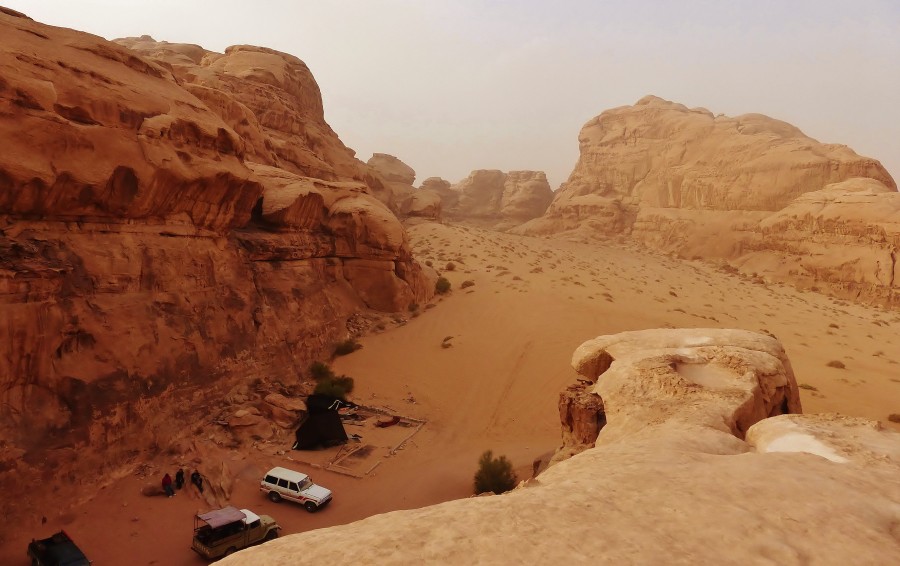
Jordan; Wadi Rum.
When I went down into the desert, one young Bedouin – Ahmed, offered me that I could join his two tourists from Canada for 20JD, if I would help him collect firewood and cook for everyone. Of course, I agreed, the more that it was not a trip 3h, as it usually happens, but full-day with overnight stay in the Bedouin camp. So we drove through the desert 4×4 Jeep and we admired the desert nature, mountains and caravan camels. A couple from Canada, after 60, sat in the back of the observation deck, and I with Ahmed in the front. Sometimes I would also help push the Jeep when it got stuck in the soft sand, and when we stood for a meal under the rock, I first picked up the bread, then started the fire, then heated the Bedouin specialties and cut the tomatoes. We were in the desert, but it was very culturally, because I and Bedouin first laid out the mat, and then I spread tuna, cheese, beans and poured tea. Beduin joked that “today we have British tea with Polish flavor”. Everyone was happy and I admit that it was a good experience. Bedouin was happy because he had a Polish midfielder,and the Canadians were also happy because they had a cook and a good photographer. It was exotic and our trip was great.
During the expedition to Wadi Rum, we also took stops at specific places of interest, such as:
- Anfaishiyya Inscriptions ; it is a Nabataean art carved in rocks depicting caravans of camels, hunting hunters and various animals. This type of inscription is quite common in Wadi Rum, which testifies to the rich history of this place. Other inscriptions I recommend are also Alameleh Inscriptions , located near the Seven Pillars of Wisdom.
- Then we stopped to see the Sand Dunes of Al-Hasana , to which I climbed first, and then quickly walked down the soft sand. There are many sand dunes in Wadi Rum, some of which are on the ground and others in higher parts of the mountains. The next day I climbed the red dunes up in the mountains, from where I had a good view of Wadi Rum and the Bedouin camp. (Being on the sand dunes, for a moment I returned to my memories of Mongolia when I was in the Gobi desert, sand dunes Khongoryn Els.)
- We have also stopped for a while at the Lawrence House (Al-Qaisr) , which is not much left today. The house of Lawrence was built in the place of the Nabatean temple and is in the color of the desert. Standing there, I advise you to look at the red sand dunes.
- There are also rocky bridges in Wadi Rum , which looks very attractive. Imagine rock formations from red sandstone, with empty space in the middle. First I saw the Burdah Bridge , which was far away at the top of the mountain. You can climb it without equipment, but it is a more demanding trip. A much better place was the rock bridge Umm Fruth , which is low and on which I climbed in a few minutes; in the margins, in the company of the Belgians, who had me earlier. I recommend both bridges, although in Burdah it is better to have a guide because there are no signs in Wadi Rum. More demanding travelers can also ask about Mały Skalny Most (Rakhabat al-Wadak) but in my opinion it is not necessary.
In the evening we arrived at the Bedouin village in the desert. These were large, versatile, black tents closed; in the middle there was a hearth on which I prepared dinner, and there were also mattresses with blankets around. Outside there was also a bathroom with a rock wall and a hot shower, because there were solar panels on the roof. Canadians rested and I went with the Bedouin to the desert for firewood. We pulled out the bushes dried by the sun, and I admit that it was a great pleasure in the silence of the desert and near the starry sky. Then we came back with fuel, the bedouin lit a fire and made dinners for everyone. I cut the potatoes, seasoned the chicken and had several dishes. After dinner, I went to the desert again, for I heard roaring camels from a distance. So I went out to them with bread,I fed them and stroked them. Only I do camels, alone in the dark Wadi Rum desert. That night I slept sweetly on the mattress, by the stove, in the Bedouin tent.
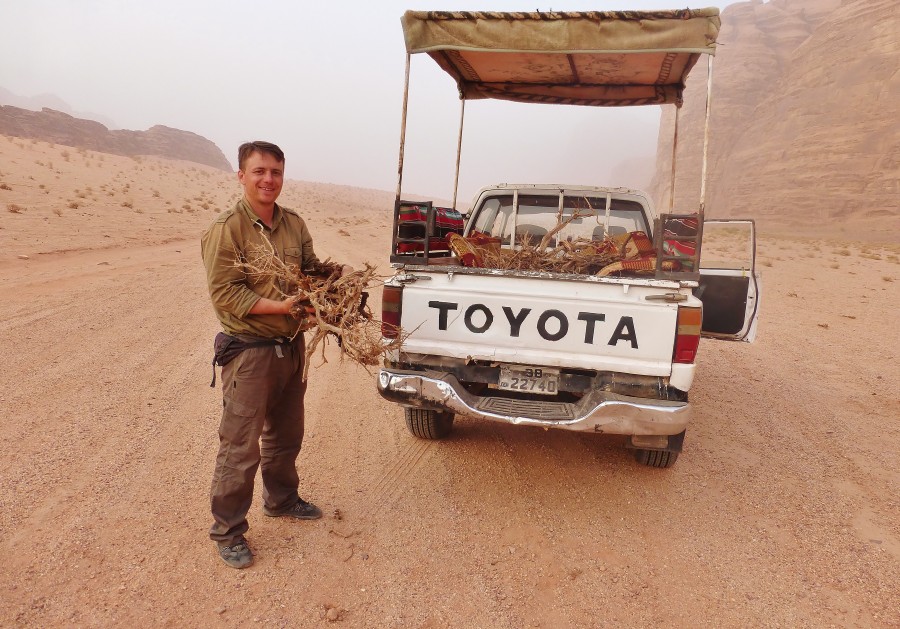
Jordan; I helped to collect firewood at Wadi Rum desert.
In the morning I prepared breakfast for the Canadians, and then we set out on another adventure. The Canadians have already returned to the village of Rum on camels, and I went to the area. Our camp was in the Mahraq area, thanks to which I saw a very small cave with a low desert-colored wall. Taking advantage of this opportunity, I also climbed a large sand dune, other than before, and upstairs. Overcoming the interesting rock formations and the red sand of the dunes, I reached the top, from where I could enjoy the beautiful view of Wadi Rum. In addition to the desert landscape, I also saw camel caravans, Jeeps passing with tourists, and Khazali Canyon where I was just going. Then I got into the Jeep, and after about a 10-minute adventure ride on the sandy and hot sands of the desert, I said good-bye to Beduin and went on a lonely crossing through the desert to the Canyon of Khazali.
My lonely adventure in Wadi Rum
I thought that returning with a Bedouin to the village of Rum would be the end of my adventure, and I wanted to feel what it was like to live in the desert alone and spend the whole day and night there. The Bedouin directed me in which way I should go, so that I would not get lost, and left me alone. For less than an hour I was walking in the desert, I could see mountains, dunes, and dry bushes sticking out of the sand. I also found animal remains a few times, so I took the goat’s horns and jaws as souvenirs. I like these kind of travel suites. It was hot, although my distance was short, and for that I had enough water. Soon I got to the Khazali Canyon, a narrow and relatively short canyon as it was only 150m long. In a hot desert, however, a canyon of this type is very helpful as it offers shade. The canyon was very narrow in places, and there were inscriptions on the rock walls made by Bedouin ancestors. From there I went back to Lawrence’s Spring, where I climbed the mountain again and had a cup of tea, then covered another 2km to the village of Rum. I put my tent up, repacked, and walked to a different part of the desert, away from the village where I camped.
For the rest of the day, I walked in the desert, picked up brushwood, and built a fire. When it got dark, I sat alone by my fire, drank tea and ate what I could buy in the village of Rum. At one point my fire started to weaken and my flashlight hardly worked so I couldn’t do anything. The desert at night is so dark that you can’t even see your own nose. However, I was lucky, because after dark, the young Bedouins drive fast in their cars in the desert, and they have very strong lights. One of them was nice enough to park the car and turn on the lights so that I could pick up some brushwood. Just before going to sleep, I was lying on the sand, staring at the stars and listening to the sounds of the desert with a gentle breeze. It was a chilly night, but as soon as the sun rose it became hot. My tent was in a bad condition because it could not withstand the force of the wind, and I also looked very bad. Once again, I left my belongings in the desert, changed into my desert clothes and went to the ruins of ancient temples, near the village of Rum. But I was more interested in the spring in the mountains, among the rocks, because there I finally washed as much as I could. I did not have a towel with me but it did not matter because the sun dried me quickly.
On the way back I sat down at the table near the village where I met a couple from Israel, and we had a conversation. The Jews complained to me that Jordan is the only country in the Middle East where they can go. I asked if maybe he thought the Jews had something on their conscience, since the Arabs hated them so much, which he replied that nothing. I told him that the Arab countries and Europe are being destroyed by the same people, but in a different way. Arab countries are attacked, destroyed and robbed, while Europe is being destroyed by means of mass, non-white, anti-Christian immigration, and through the promotion of sexual deviations. The Jew thought for a moment and asked me who in my opinion was behind all this, because it was probably not the Jews. This was the end of our conversation. Next to him sat a Bedouin who listened to us with great interest. When I said that I was from Poland, he said that he greets me in Jordan, but without emotion. I saw that he was relaxed with the Pole. However, when he learned that they were Jews from Israel sitting in front of him, he turned red, took a deep breath, and then with clenched teeth said “welcome” to them. I understood this Beduin very well, and I think that the Jews, in their own vicious way, also understood him, but I wonder if the left-wing nonsense of the society of Western Europe and America would have any idea what to draw from this situation? I doubt it …and I think that the Jews, in their own perfidious way, also understood it, but I also wondered if the loadede with left-wing nonsense societies of Western Europe and America would have any idea what to draw from that situation? I doubt it …
I got out of the beautiful Wadi Rum desert easily. First, I went by one hitchhiking 20km to the Visitor Center, and from there another 7km by another car to the main road to Aqaba. Wadi Rum will always be remembered very well, and I recommend this adventure to all travelers, especially in the way I did it.
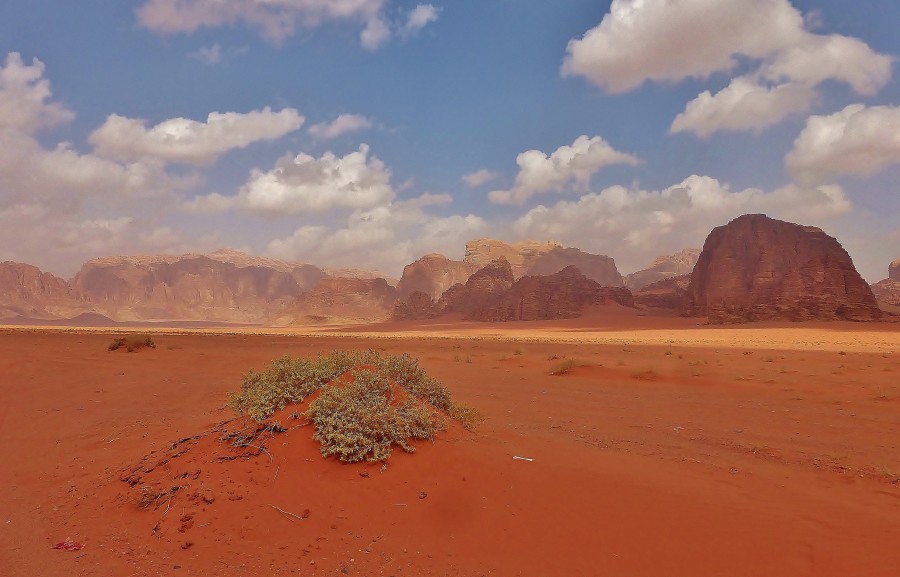
Jordan; Wadi Rum desert.
Transport to Aqaba
My transport to Aqaba would be pleasant, because I quickly found hitchhiking and I was aware that I was heading to the sea. I covered the 38 km route in about 30 minutes. When I reached the suburbs of Aqaba, I immediately got into the back of the truck, and the driver threw me at the public beach, in the shade of beautiful palms.
Aqaba
Aqaba is a very nice small town on the Red Sea, which is the place of many investments. There were several world renown hotels and good restaurants there, although Aqaba still has its traditional Arab culture. Big hotels, and similar objects do not interest me, that’s why I spent most of my time on the beach and its surroundings, and in the evenings walked around the Arab bazaar. That’s what I’m looking for in my travels – tradition and the original culture of the locals. Aqaba is growing at a rapid pace, and I suspect that in a few years globalization can destroy the city’s tradition. Importantly, Aqaba is Jordan’s answer to Eilat, a beach town in Israel, where there are more hotels, more large stores and much more distrustful people. Aqaba also has a strategic location from the tourism point of view, because it is located close to the border with Israel (Eilat), and is a convenient base for travelers traveling to Egypt (Taba). For those who come to Jordan for a few days to see only Petra and return to Israel, Aqaba is also convenient because it is only 2 hours away.
However, I would not treat Aqaba as a lodging base, because the city is extremely charming, has good food, smeared people and interesting bazaars. Aqaba also has an ancient fortress, bookstores, boat trips on the Red Sea; and is a good place to practice water sports, and to extend the Jordanian visa, up to three months. For a small amount of money, you can spend sweet moments in a pleasant, warm climate.
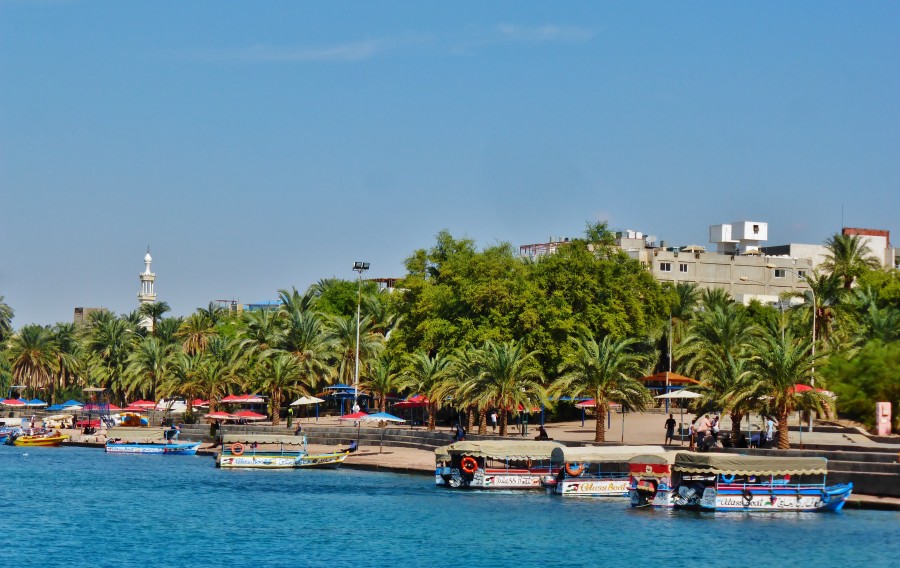
Jordan; Aqaba.
When I got to Aqaba, I planned to pitch my tent in the port near the main beach, but I was tired after Wadi Rum and had to wash my sand and dirt off myself. I felt that I needed the basics of luxury, which in a traveler’s dictionary means a bed, a warm shower, 4 walls and a roof. So I took my big backpack and went to the city and found a room at the Al-Jaber Hotel for 6JD a night, even though they wanted 10JD. I had a view of the Hussein mosque and heard prayers from time to time. I spent the rest of the day walking on the beach, swimming in the Red Sea, and then I was on a good dinner and Arabian sweets. After dark, I went to Downtown, where I spent most of my time in bookstores.
My other day in Aqaba was also very nice. First, I went to a delicious Arab breakfast, ending with bakhlava and tea, and then I bathed in the sea. I was also to see the ruins of Ayla , which are the remnants of the medieval port of Aqaba. Today, however, only foundations remained, but still an interesting object, because to this day stone arches and roads excavated in the ground have been preserved. I liked Fort Aqaba much more, which was built by Mamluks in the early 16th century, and lies by the sea, on the terrain about 50m x 50m. It is a nice little castle with Arabic inscriptions on the walls and a huge wooden door. The main square is empty, but there are nice views of the sea and the minaret, the stone walls and the flag of Jordan on the mast.
On the other side of the sea, you can also see Israel. Fort Aqaba was also occupied for a long time and extended by the Ottoman Turks, and was used as a hotel (khan) for pilgrims heading for Mecca. In 1917, the brave British fleet helped to throw the Turks out of the fort, after which the Arabs organized a revolution and expelled the Turks once and for all. I admit that I liked the Hussein mosque too. It is in white, has a large dome and a minaret, and lies on a green square and is surrounded by palm trees. The Hussein Mosque is a very nice place that gives some shade, and I think that as long as it stays in Jordan (and not, for example, in England), I heartily recommend it.
That day I was swimming again in the Red Sea, and walking around the shore I watched Jordanian families at picnics under palm trees. In the Arab countries, every cluster of people immediately turns into a bazaar, which is why there were also many sellers here. In the evening, I went for a delicious fish to a traditional Jordanian restaurant, for only 5JD. I will always remember Aqaba very well, although I think it was also my reward for the hardships of traveling in the desert.
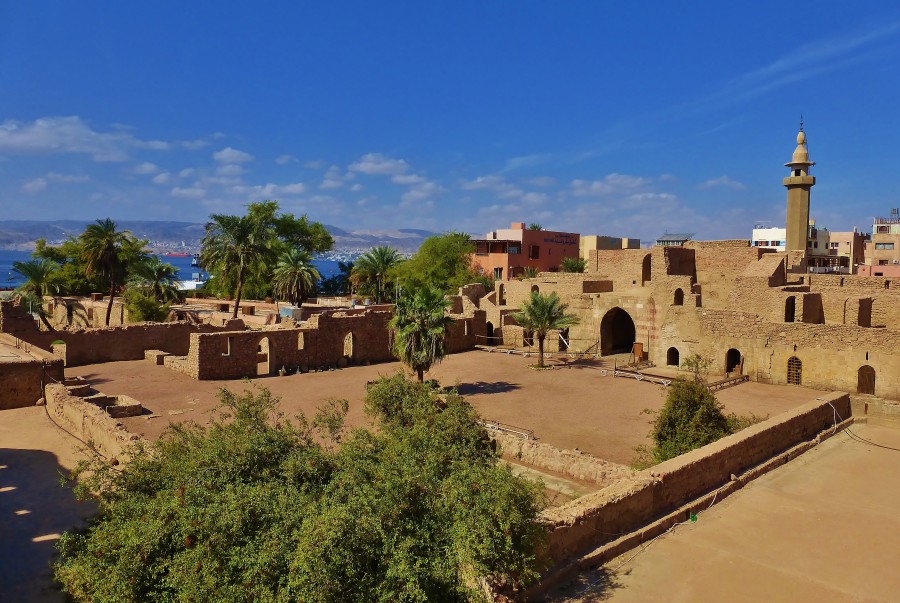
Jordan; Fort Aqaba.
Happy meeting with Saudis
Every time I travel, I always deal with people who I remember because of their appearance or interesting conversation and sometimes it is a misunderstanding resulting from cultural differences that result from merry situations. Well, being in a hotel I met a family from Saudi Arabia, a couple with two daughters, and I thought I would try to make contact with them. Here’s our conversation:
Saudi: Hi, where are you from?
Pole: From Poland. Are you on vacation? Tell me how is life in Saudi Arabia?
Saudi: Exclusive. We have Allah, Prophet Muhammad and Islam. And how do you live in Poland?
Pole: Exclusive. We have Christianity, Jesus Christ and all angels.
Saudi: Oh.
Pole: Exactly. But changing the subject, I like your daughters. Could I take this elder one for a walk and tea? I would be nice.
Saudi: (Minute of silence, after which his wife smiles, and his daughters smile even more) Rather not. Tomorrow we are going back to Saudi Arabia and we have to get up in the morning. Good night.
Pole: Good night.
I like this kind of conversation, and in passing I admit that it is a pity that Saudi Arabia does not give tourist visas, because there is something interesting in every country.
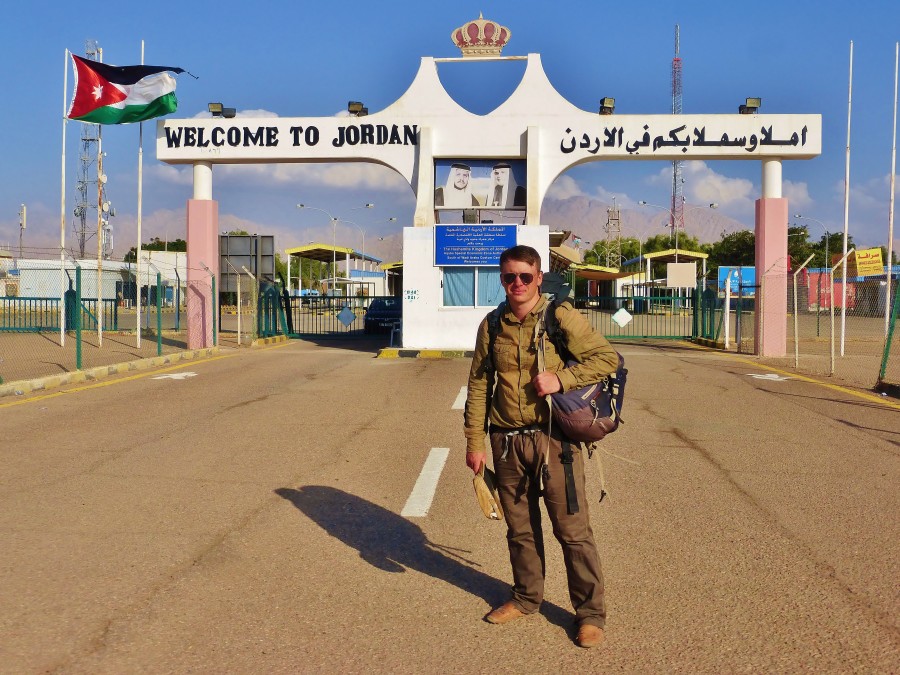
Goodbey beautiful Jordan!
Transport from Aqaba to the border with Israel
The next day I woke up around 10 am, again swimming in the sea and ate bakhlava, and then with regret in my heart I left Jordan. I took a taxi for 5 JD and went to the border with Israel. Check-in on the Jordan side was trouble-free.



